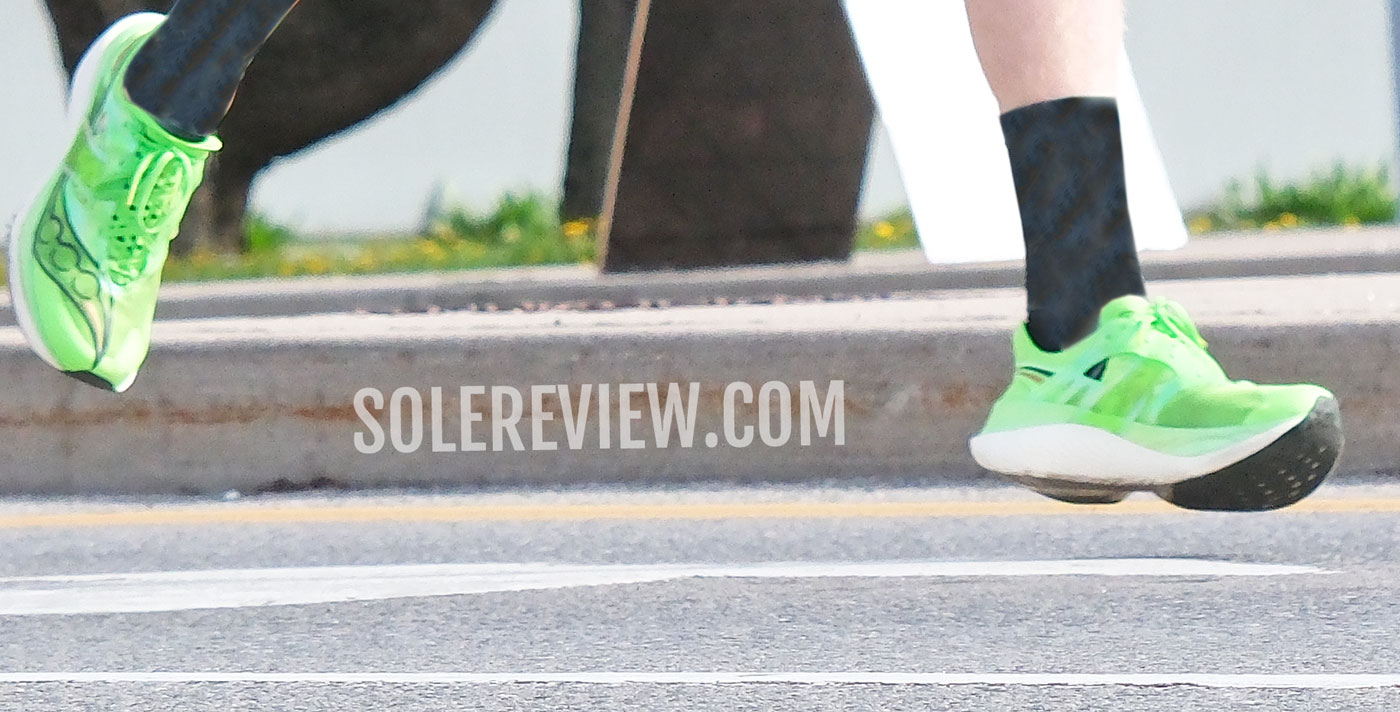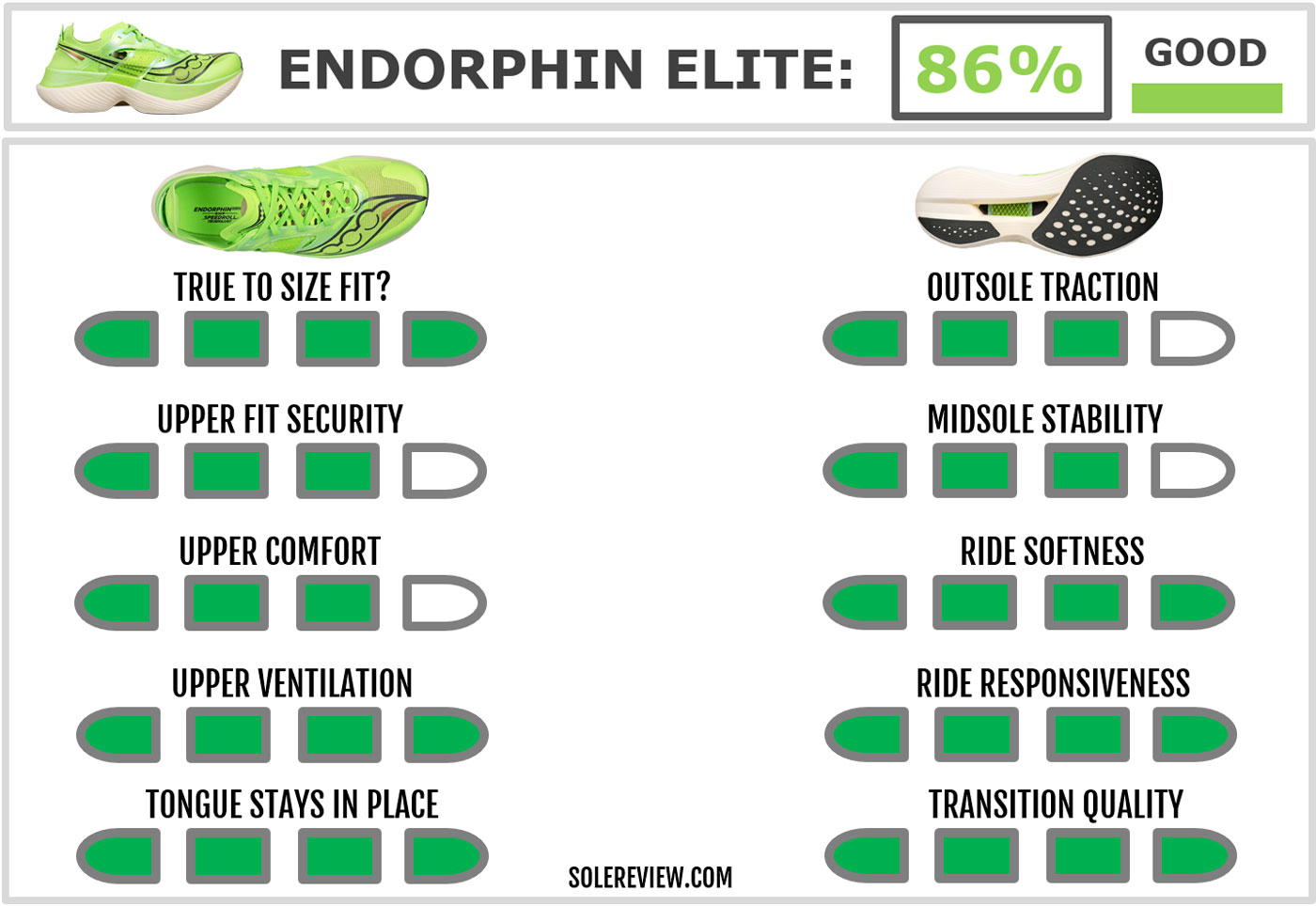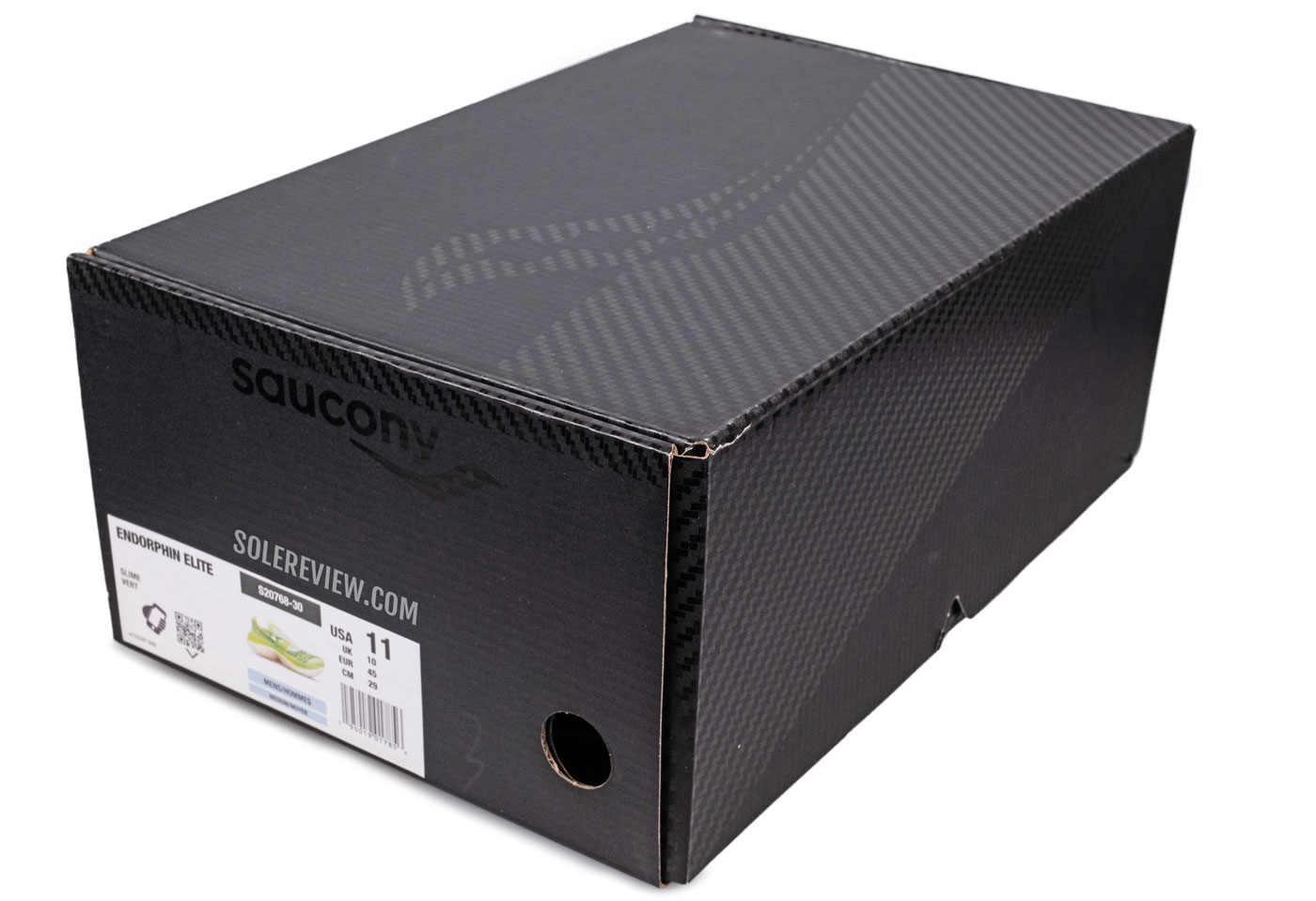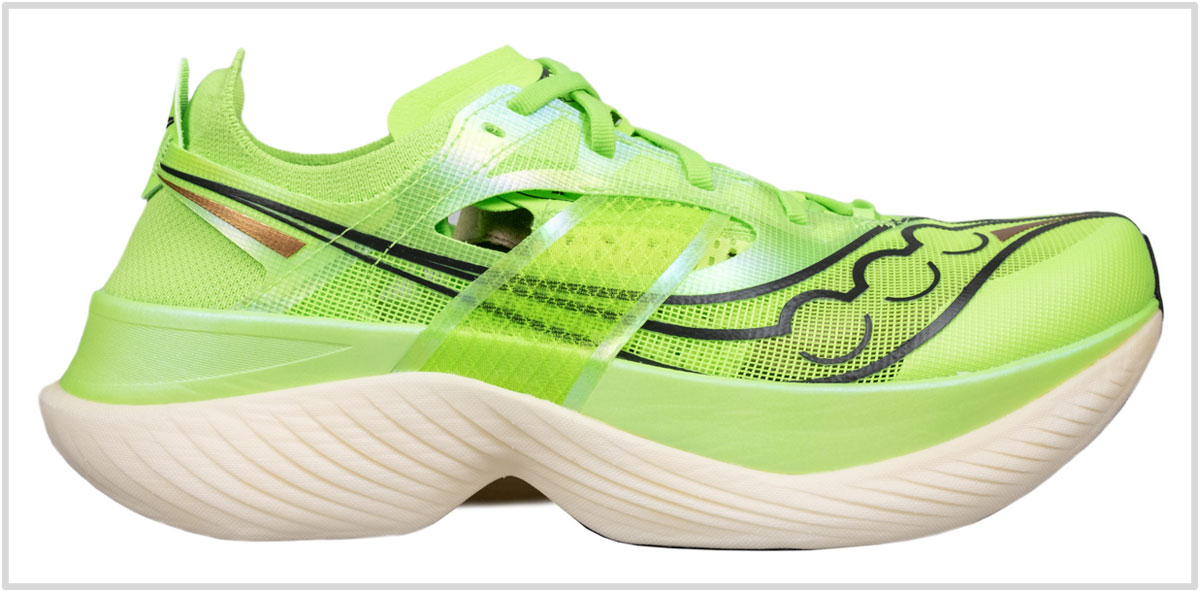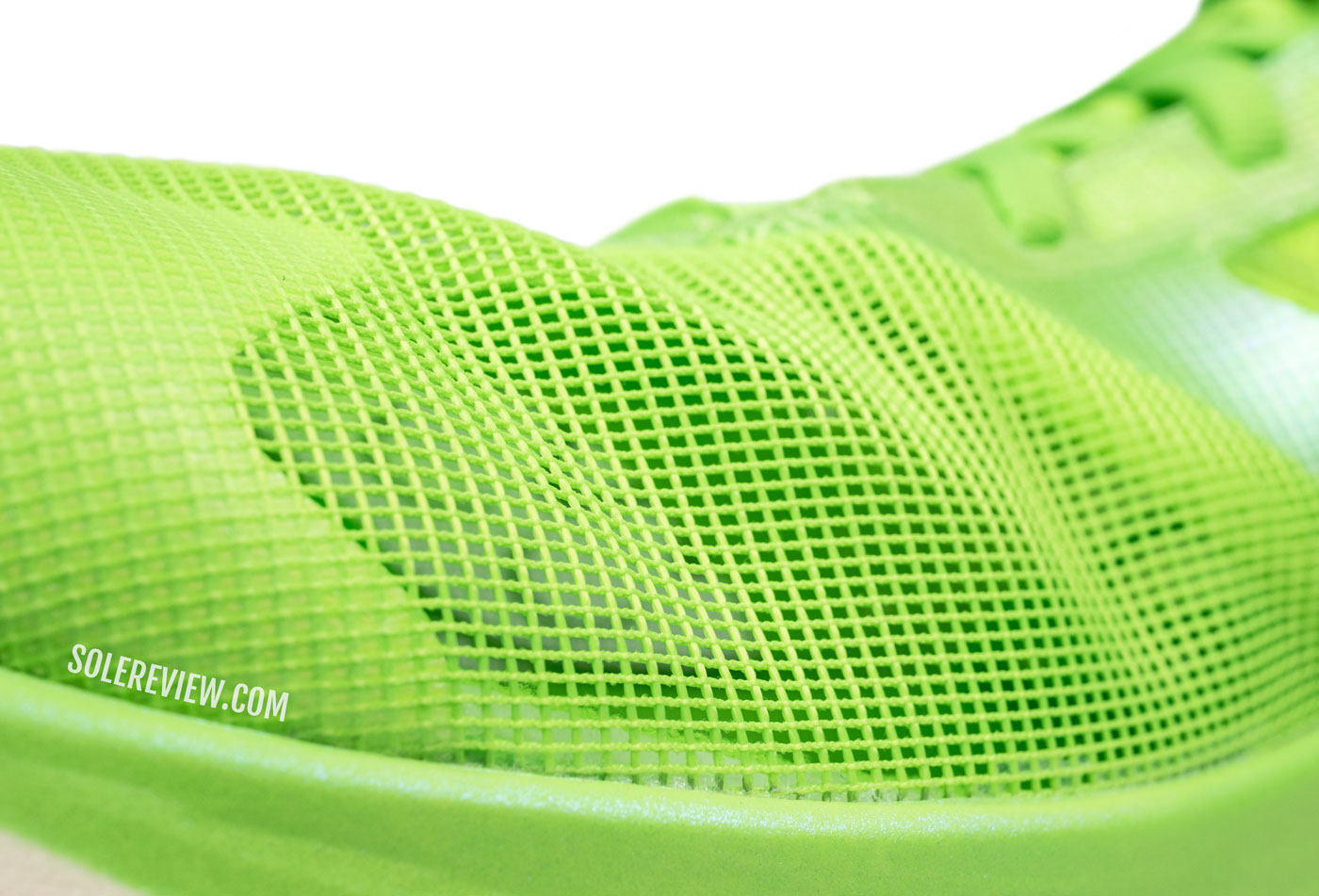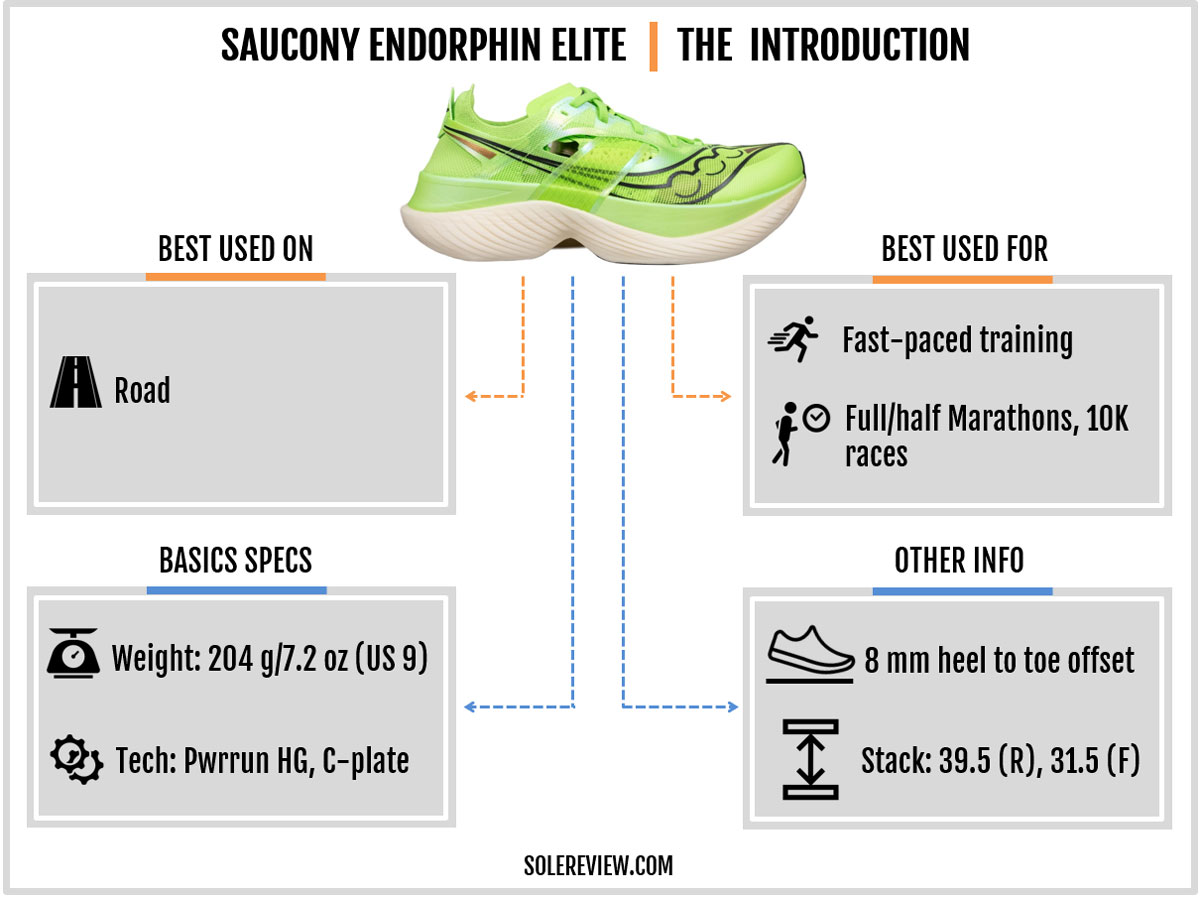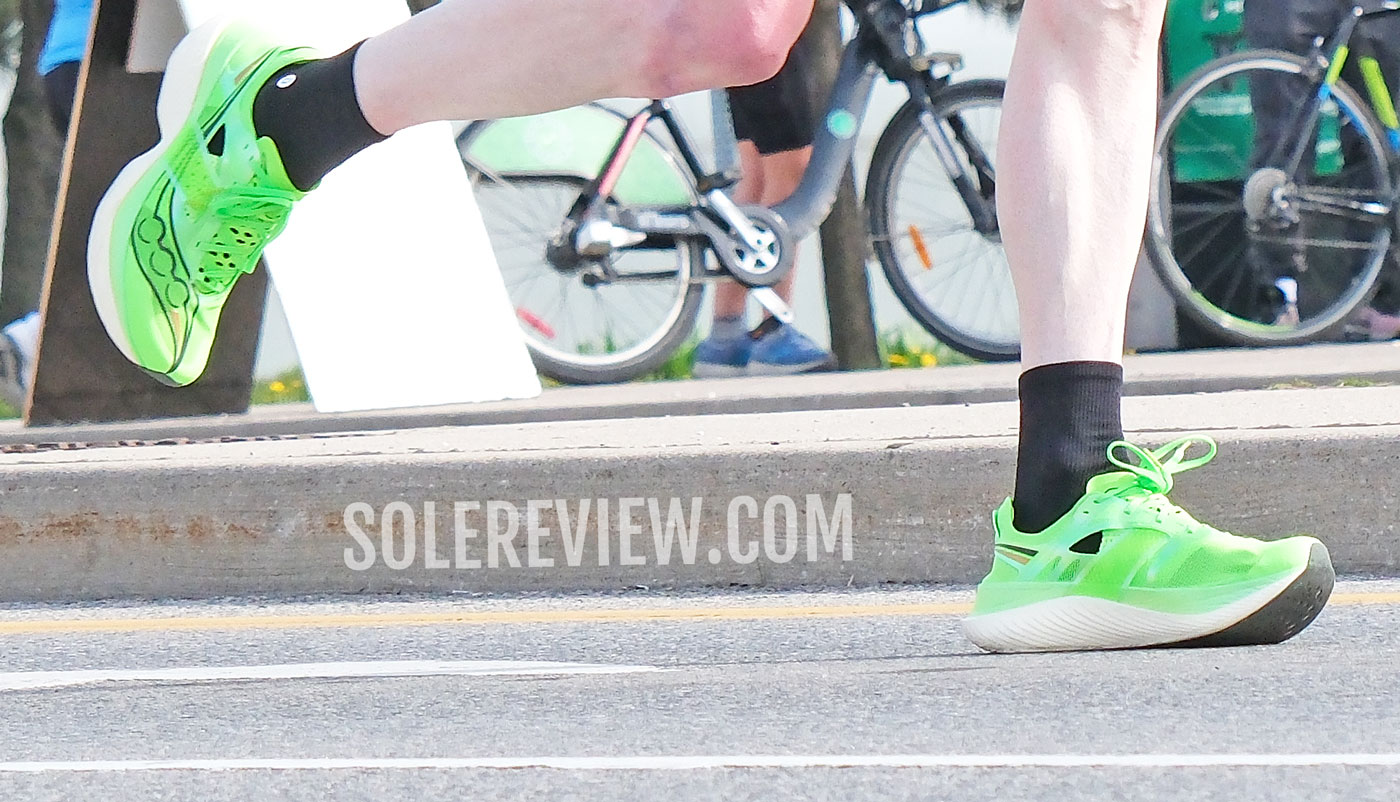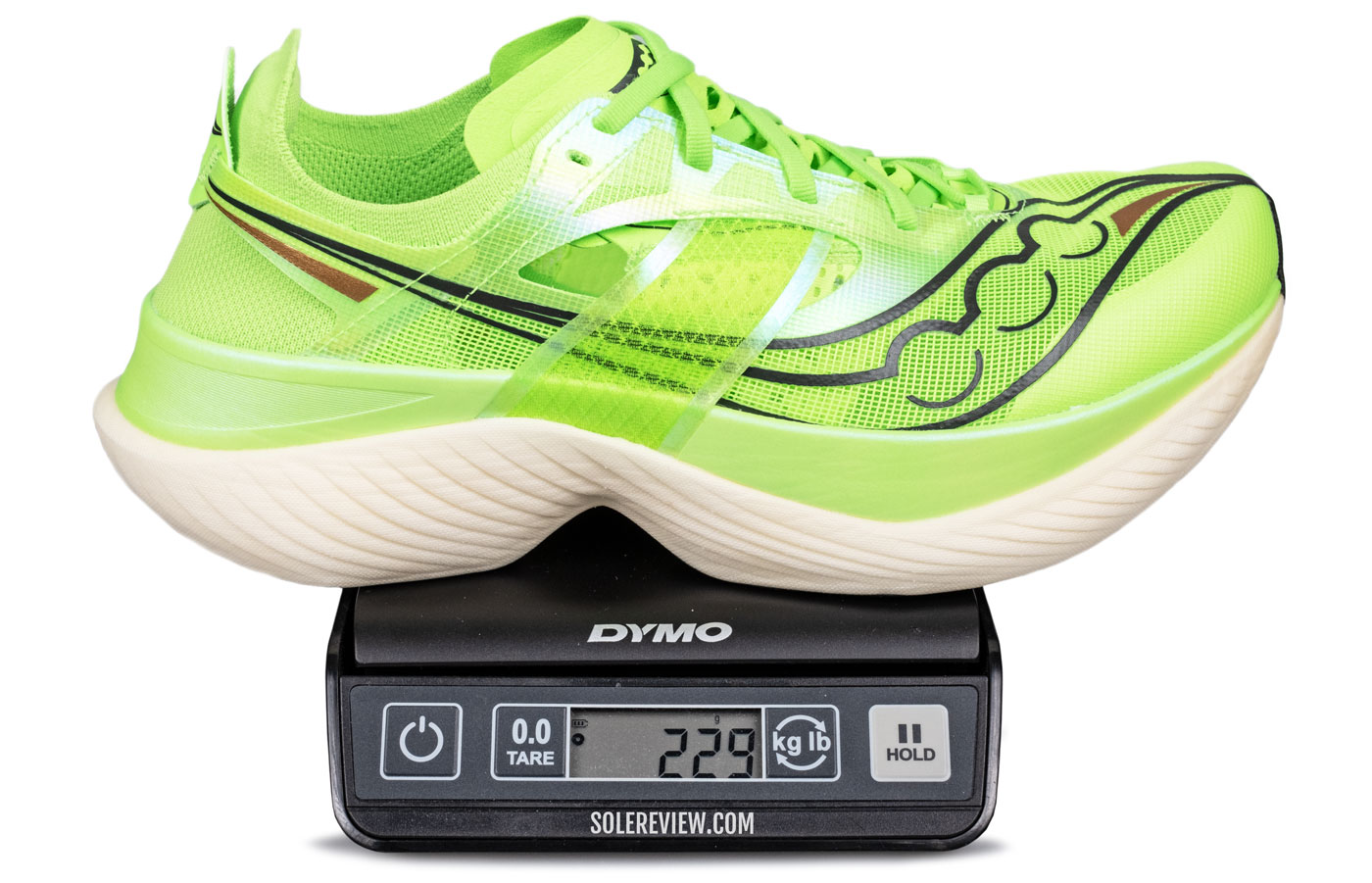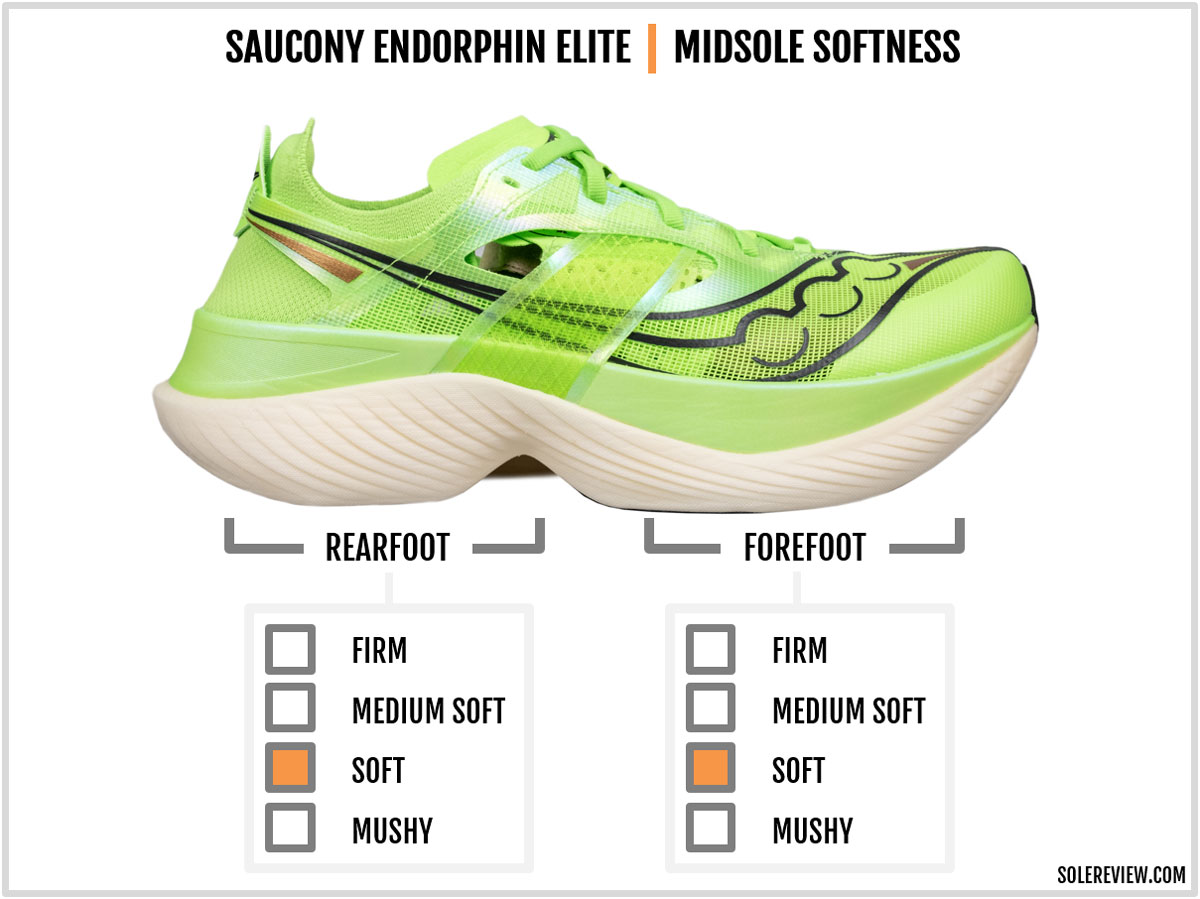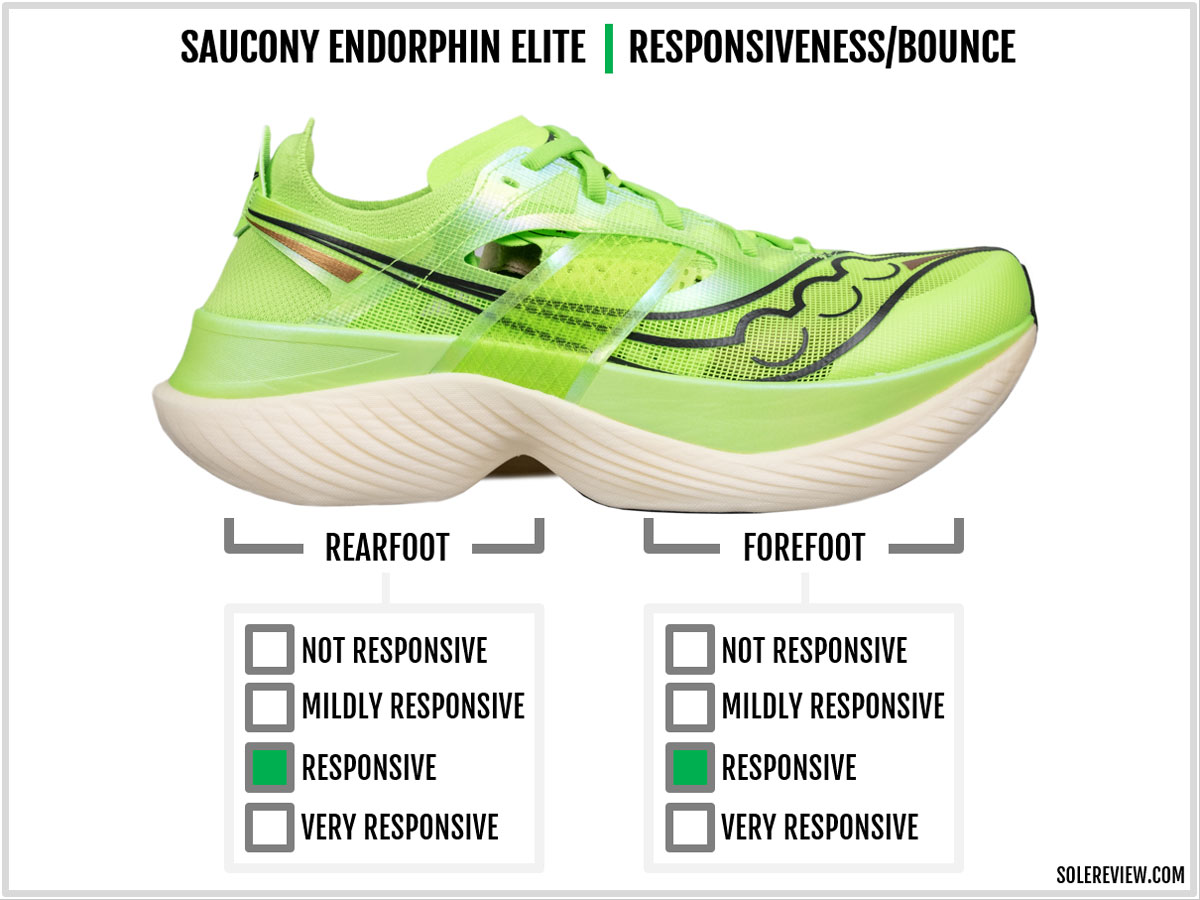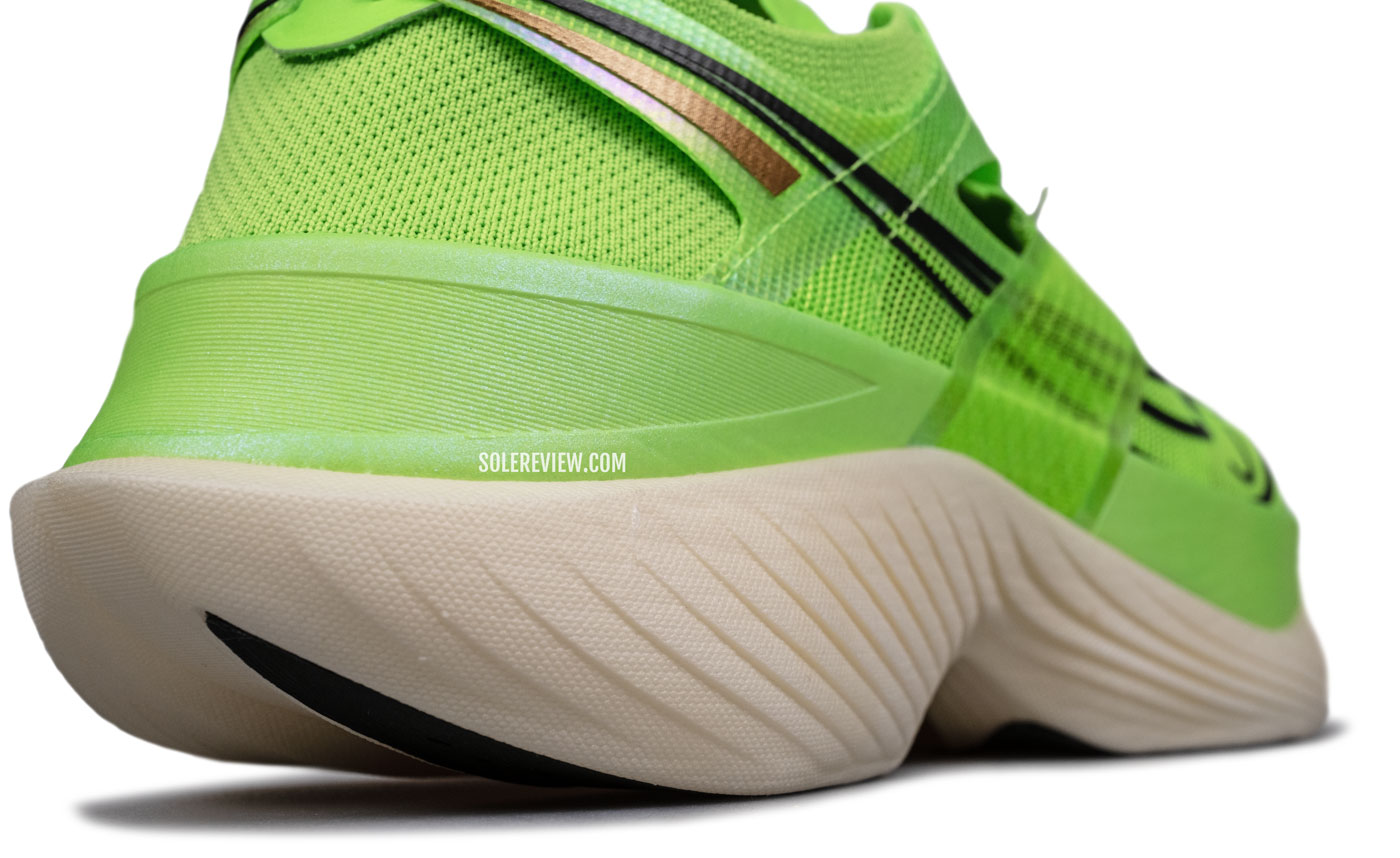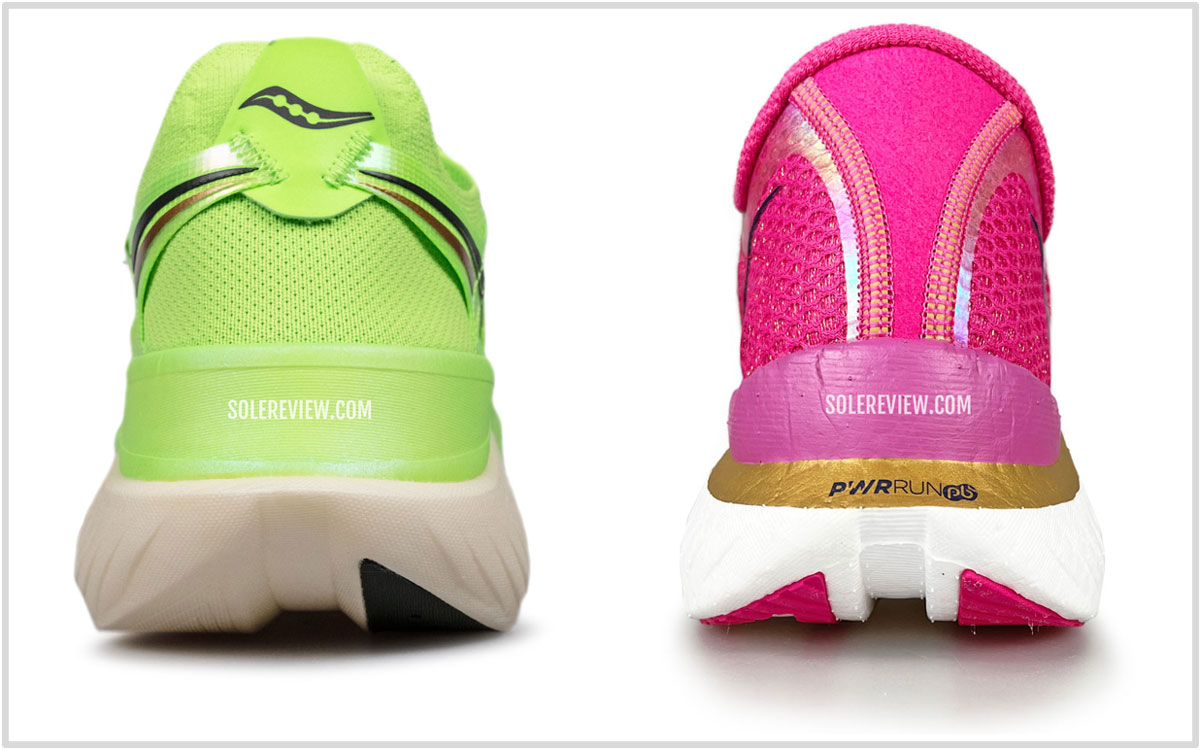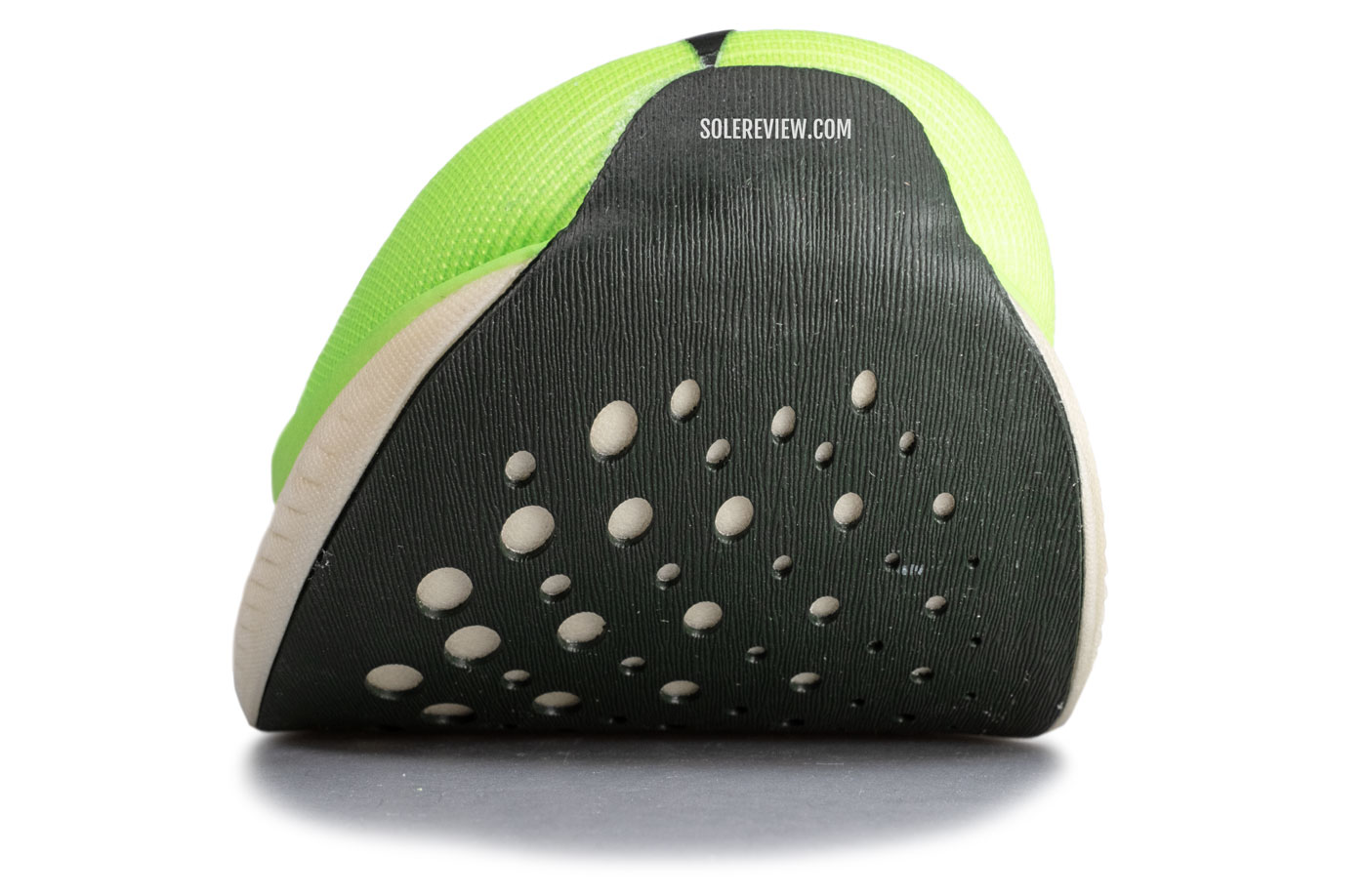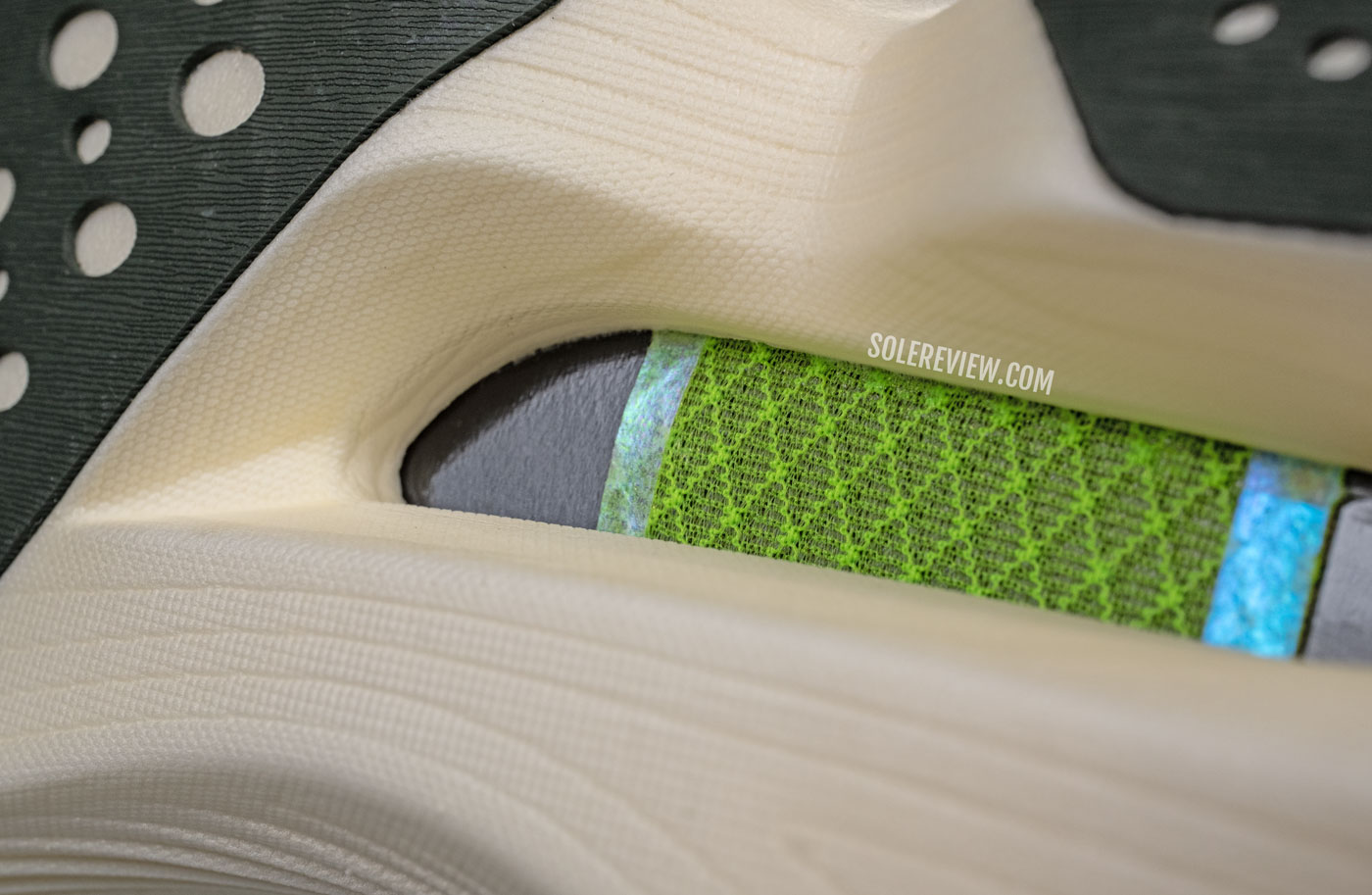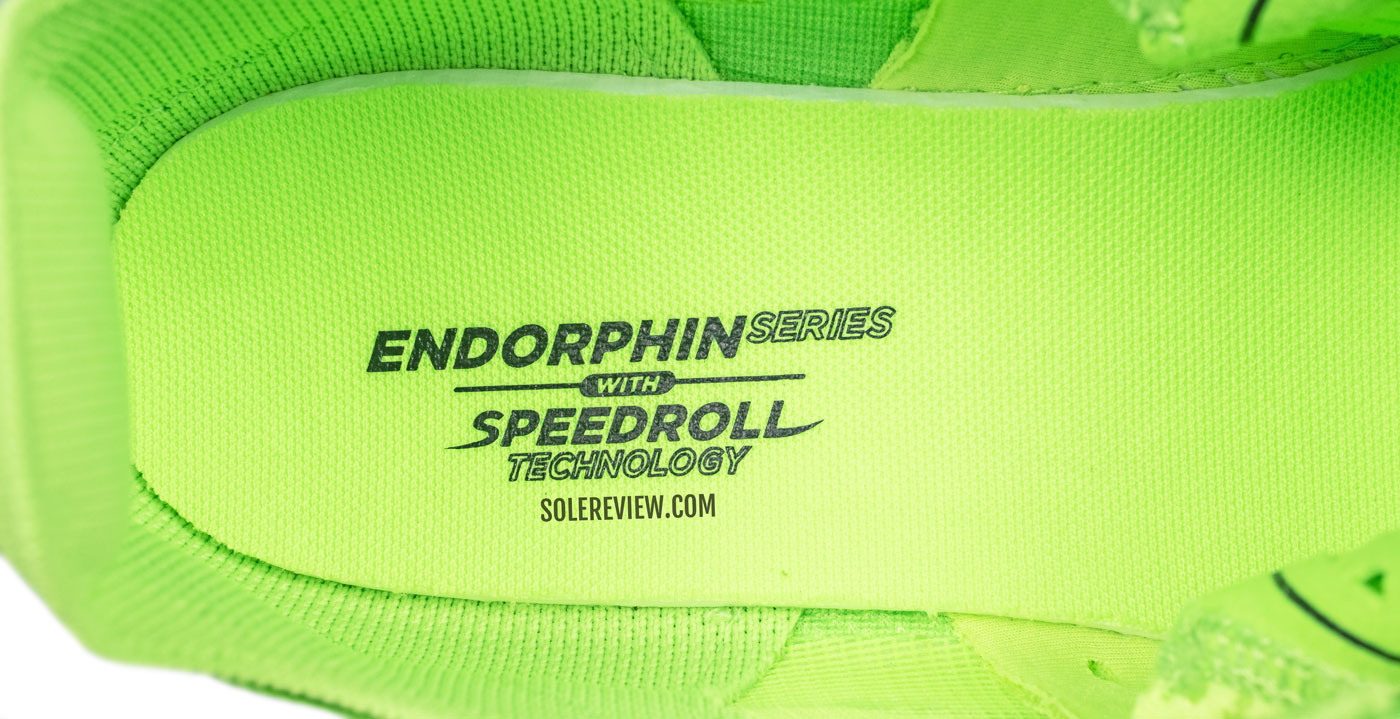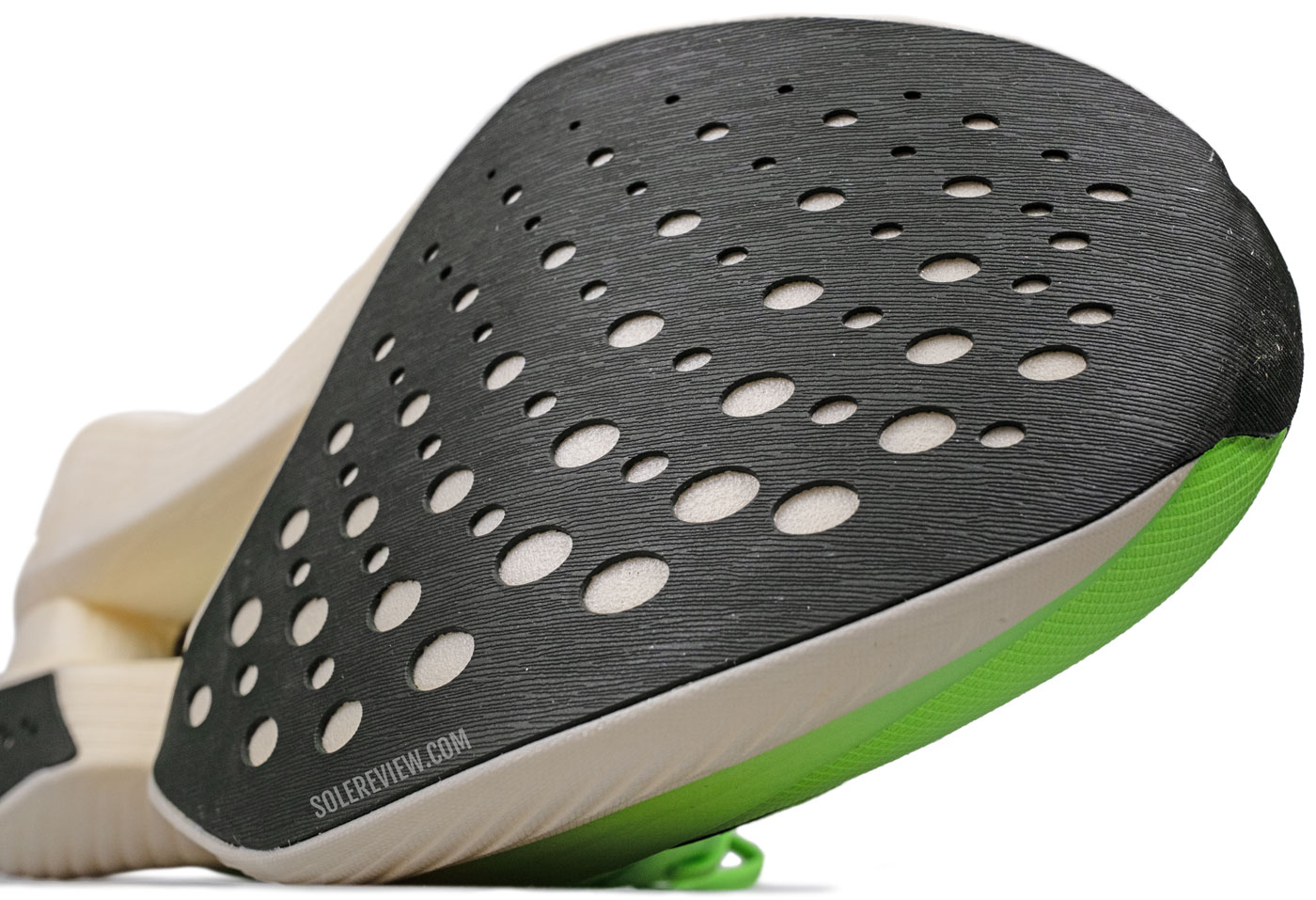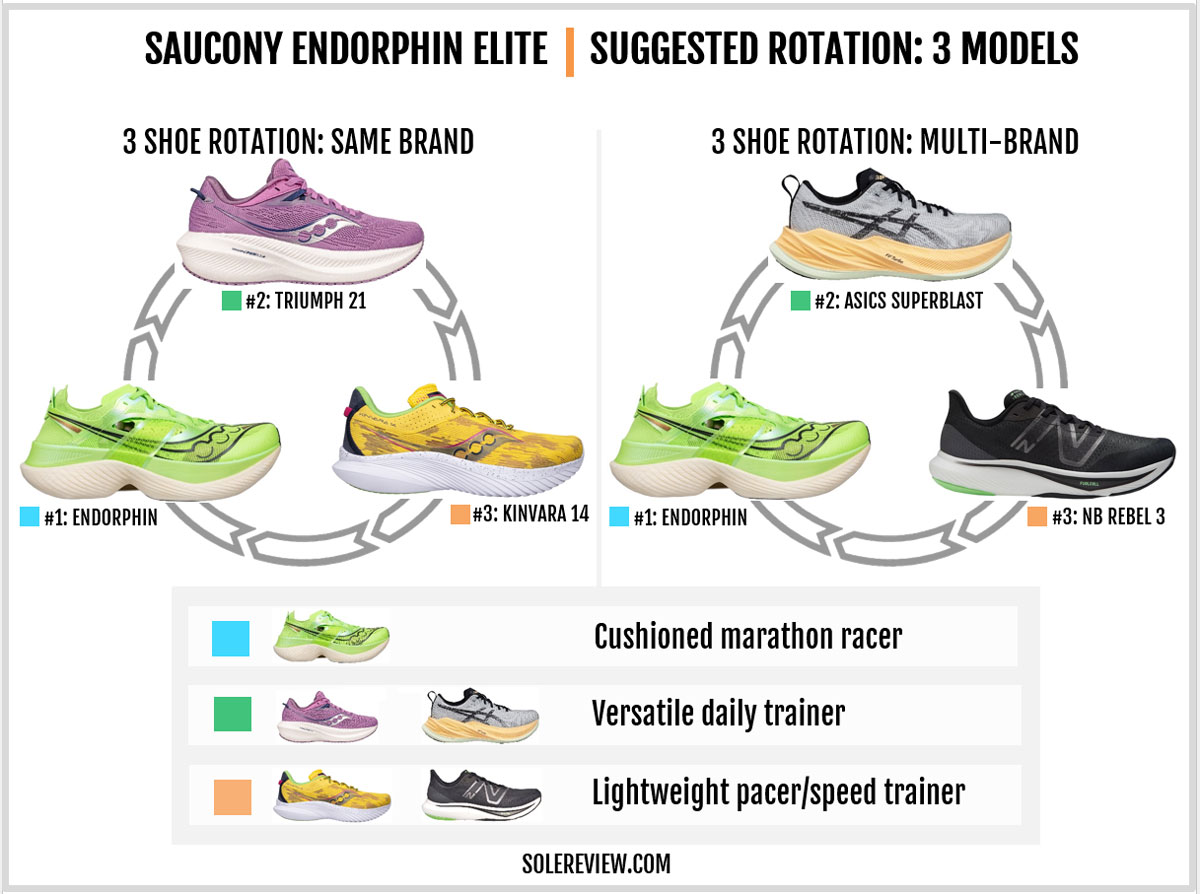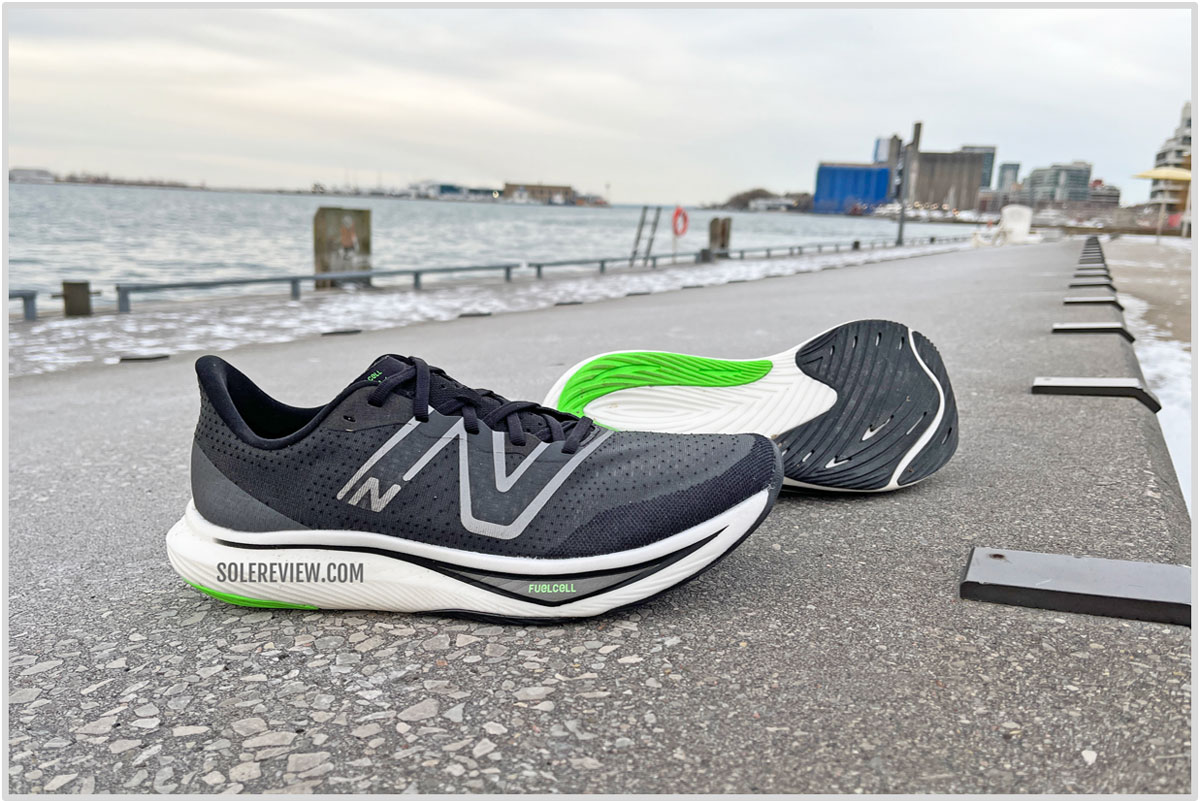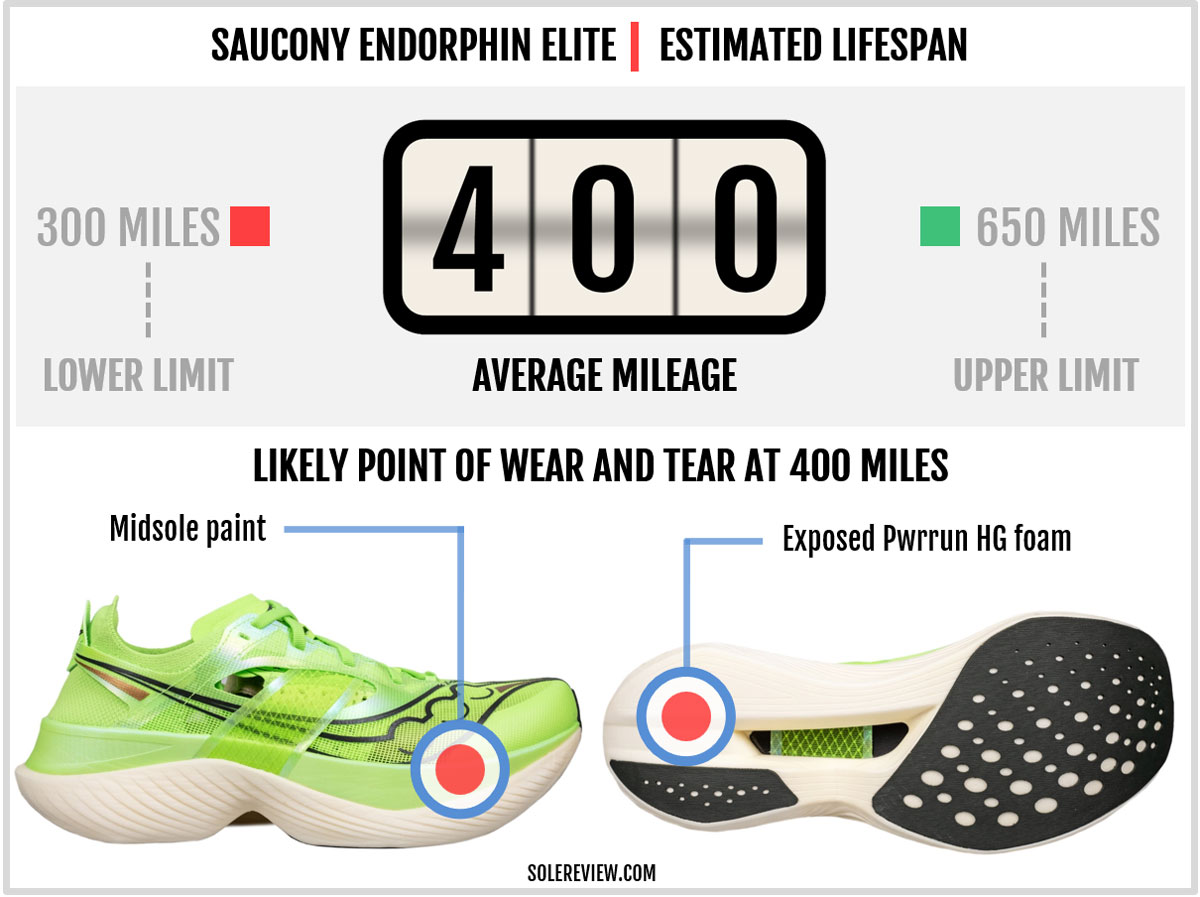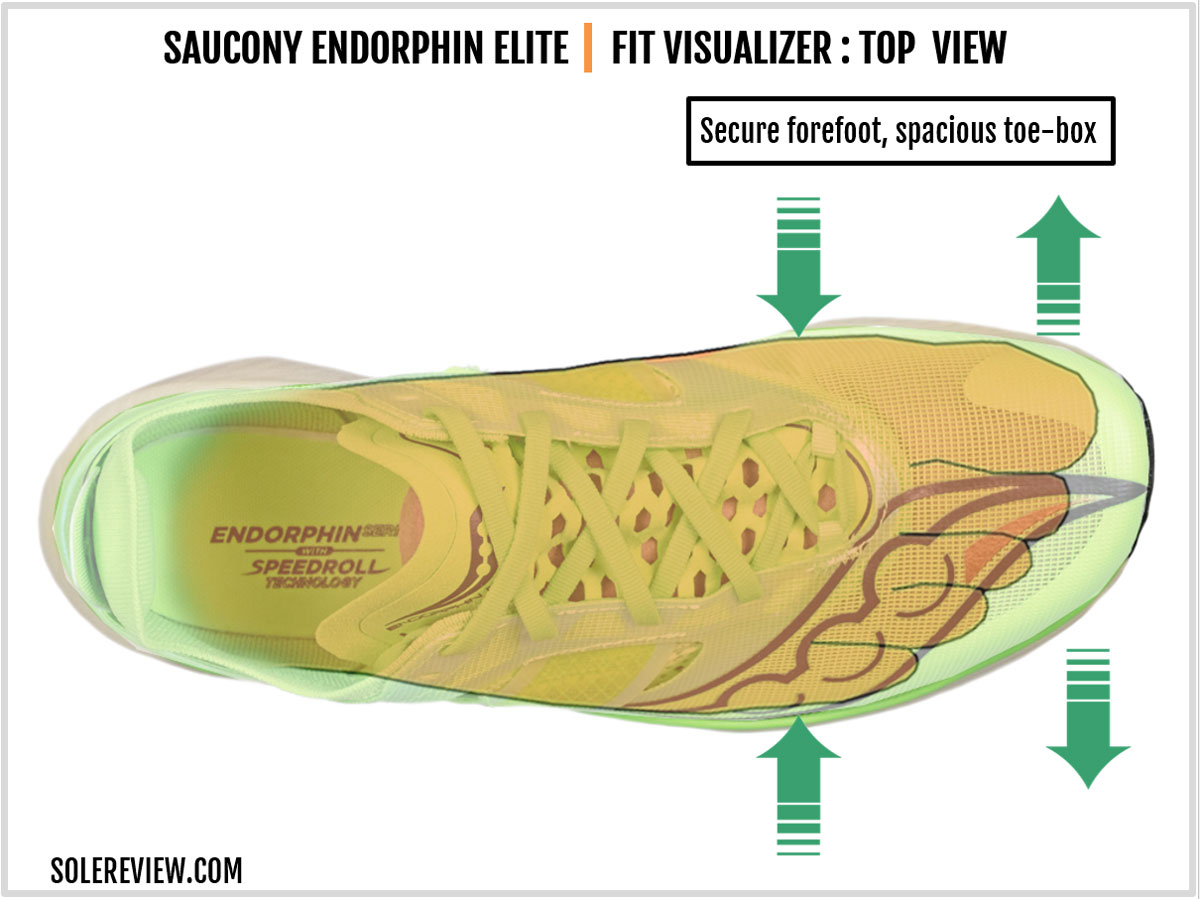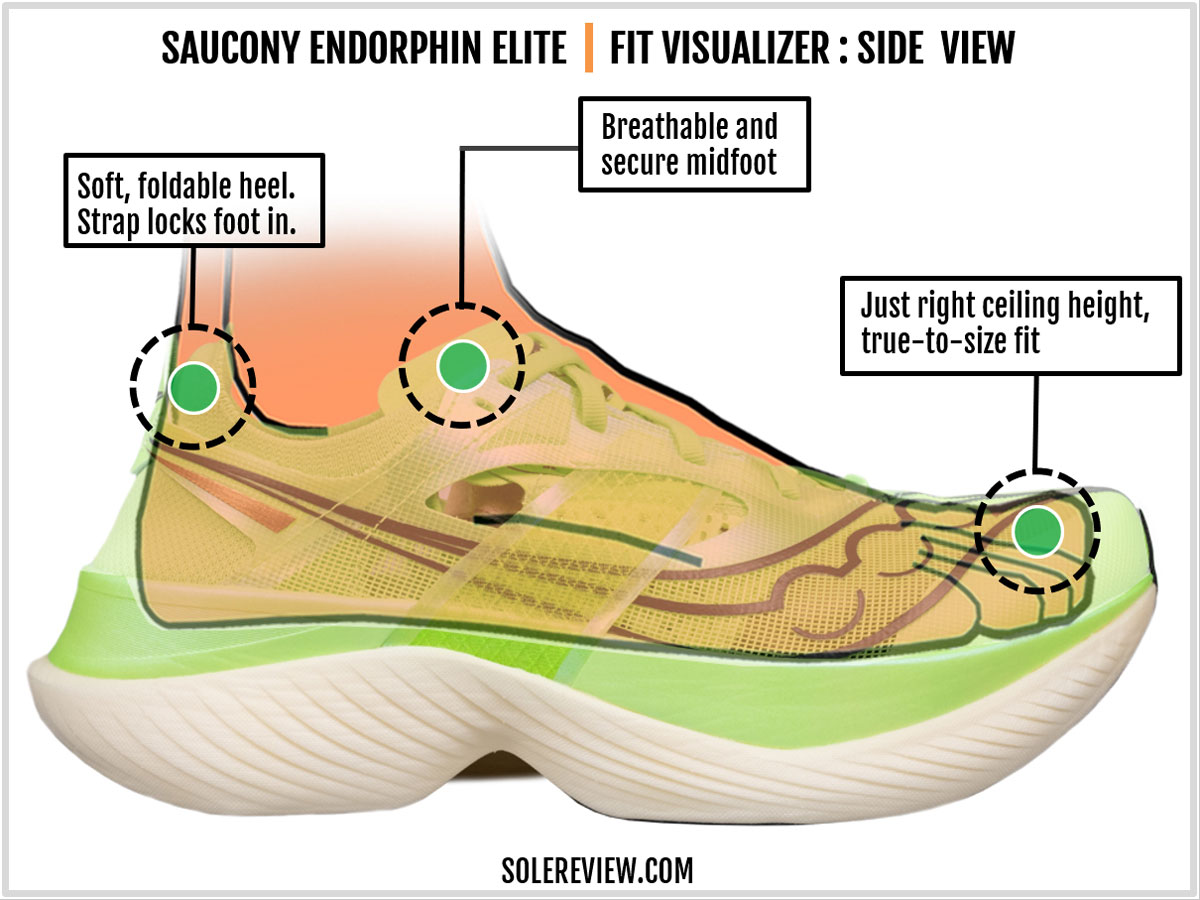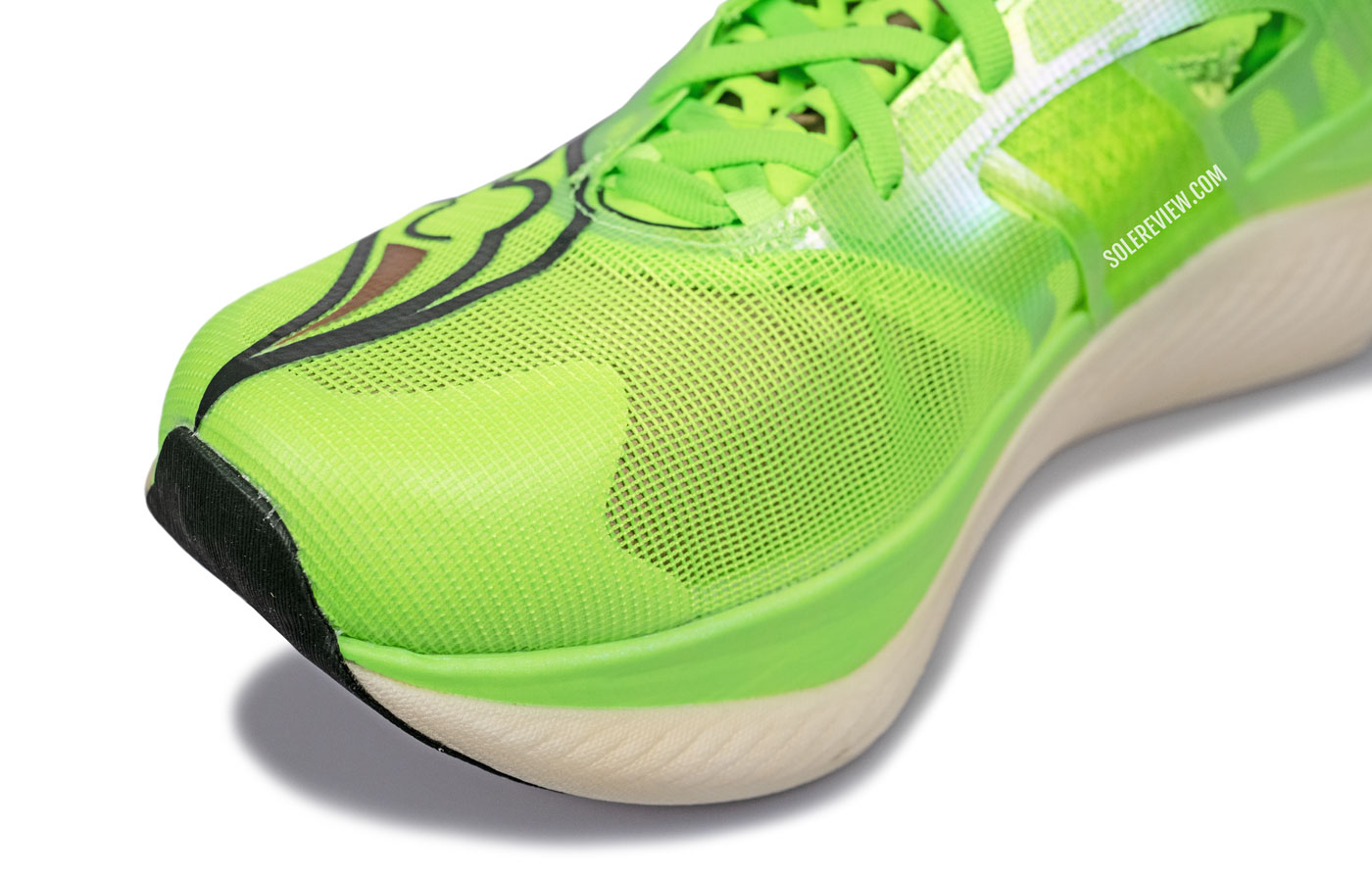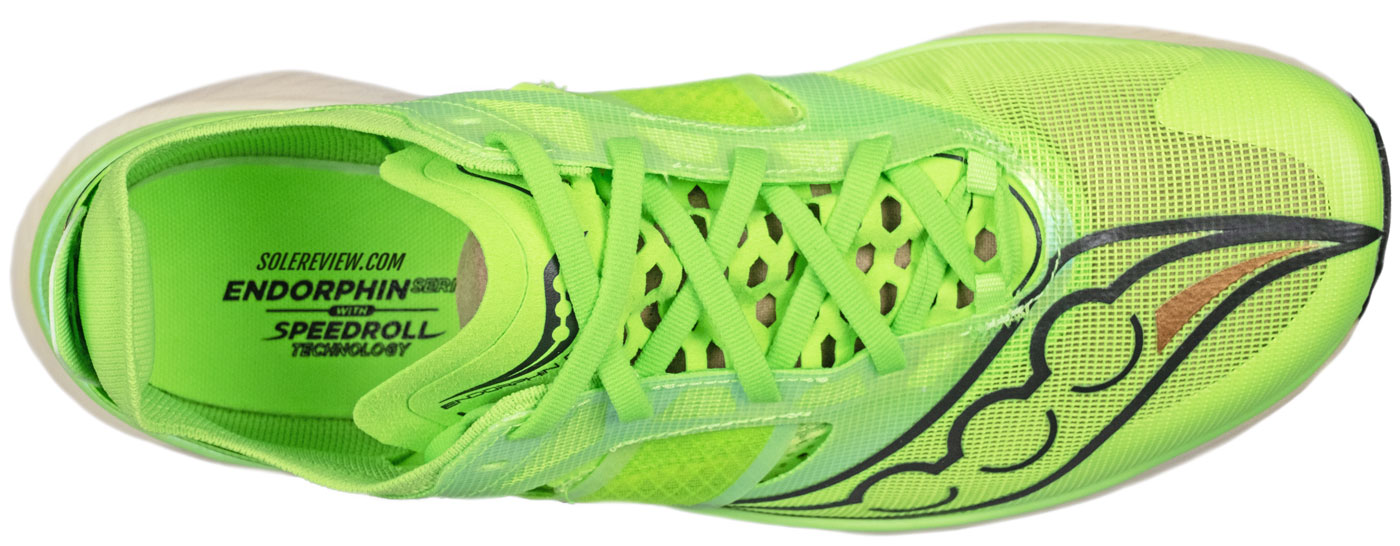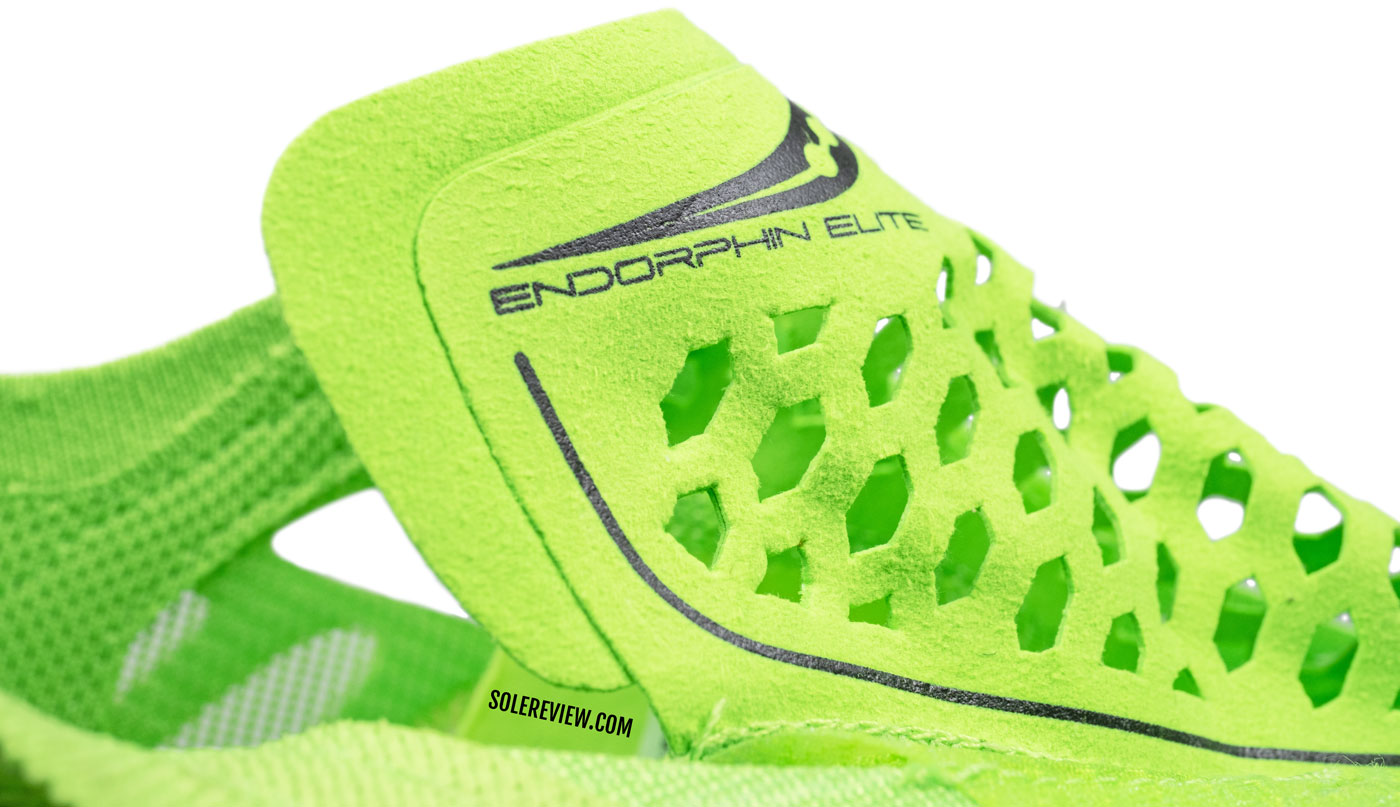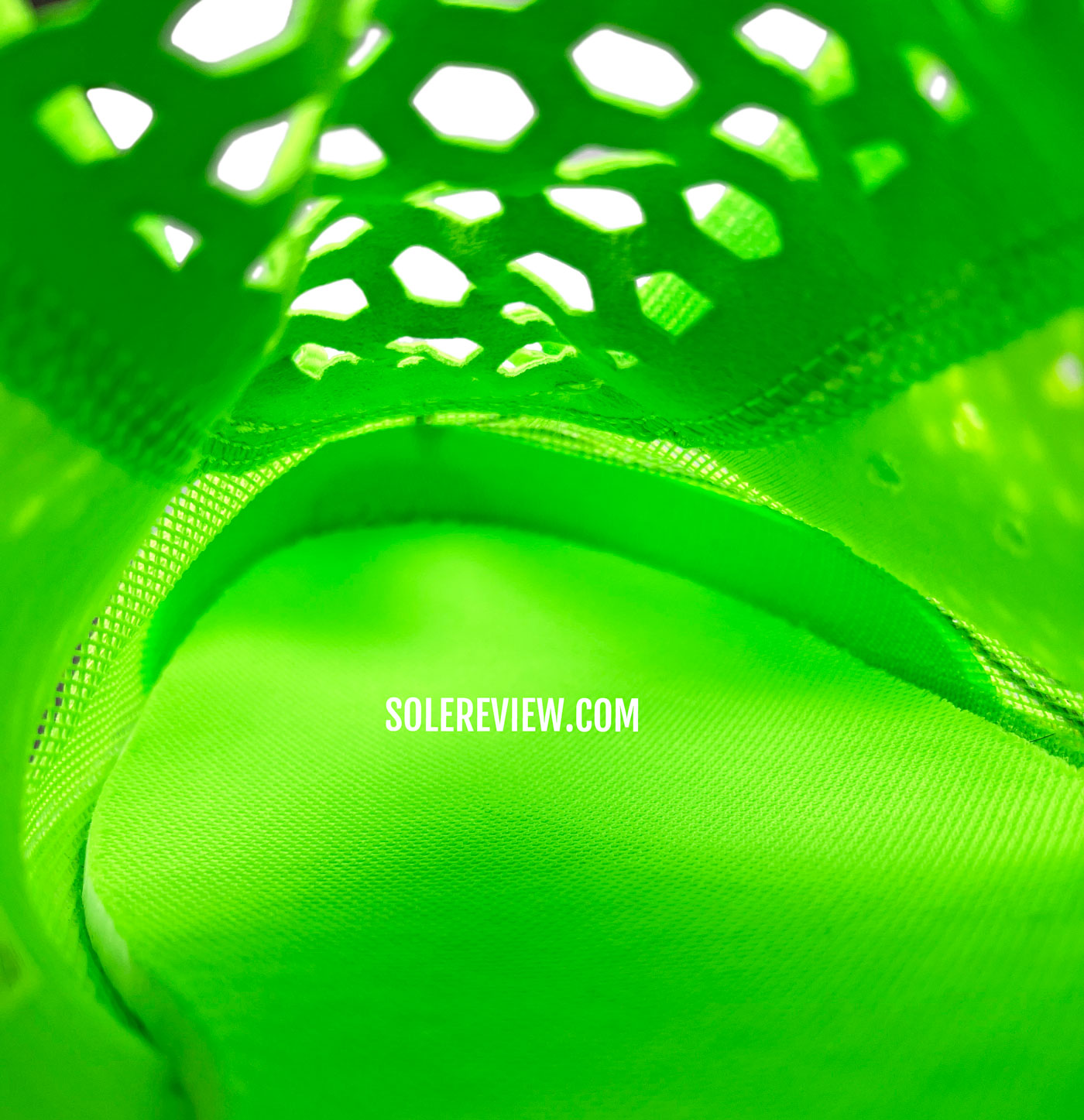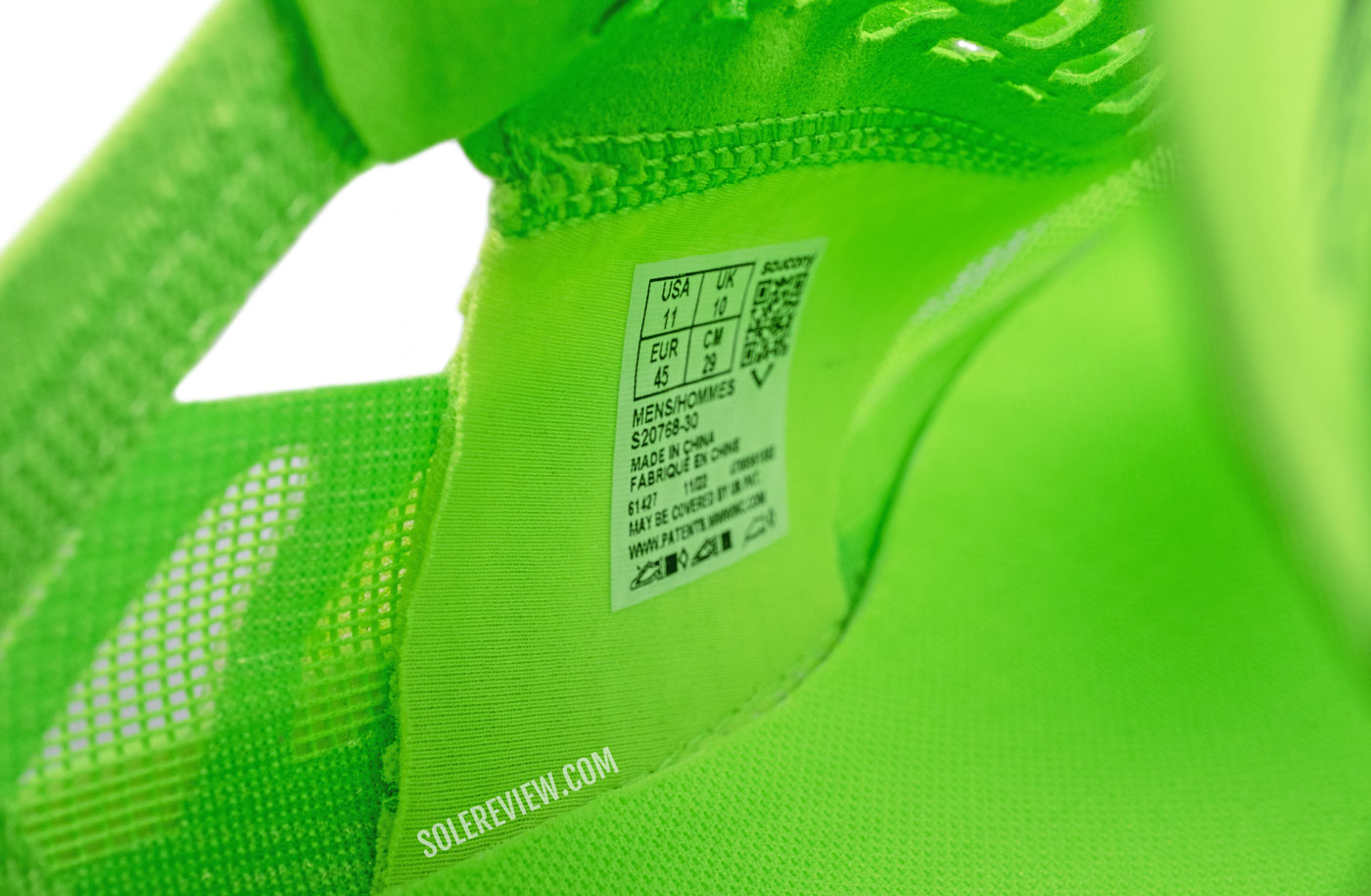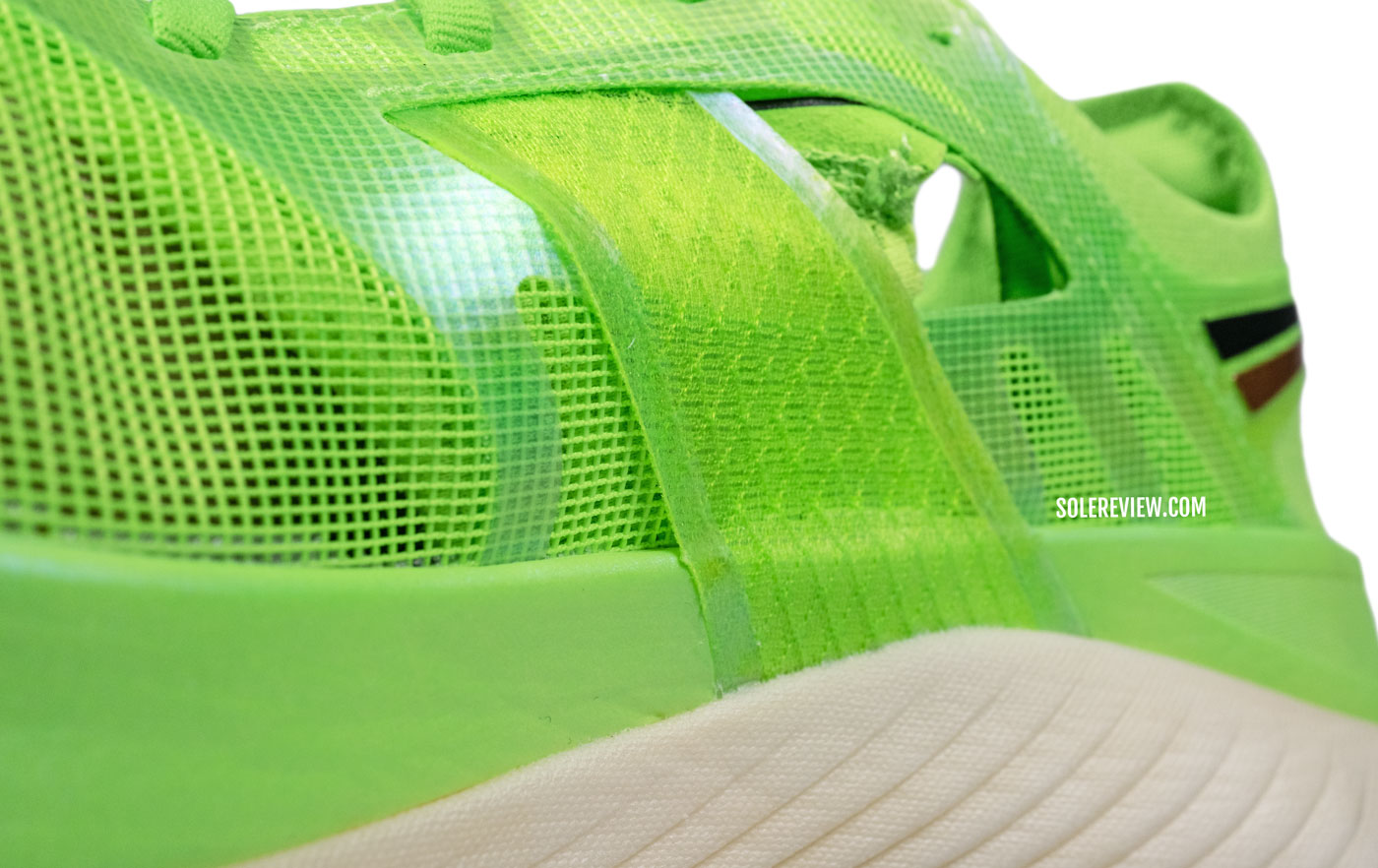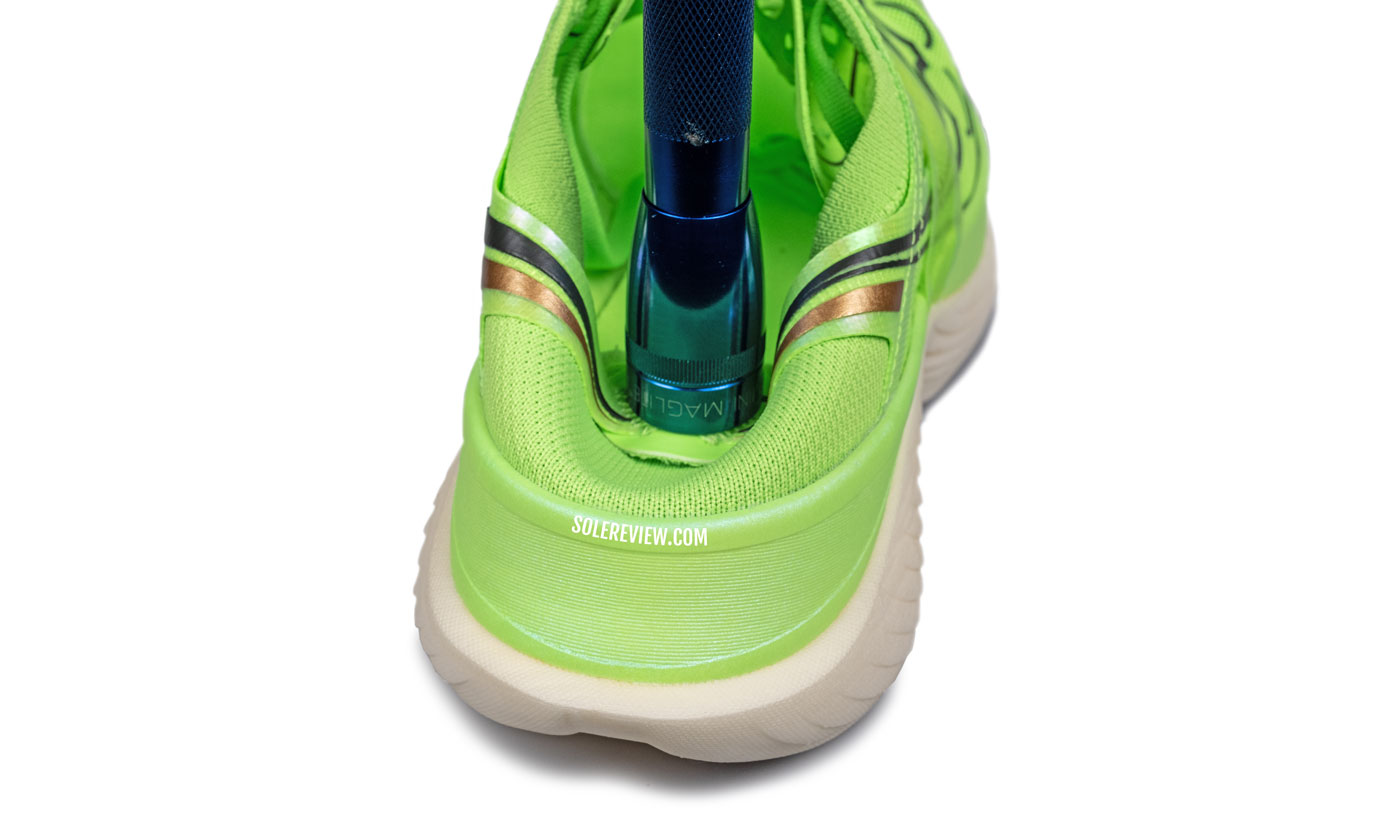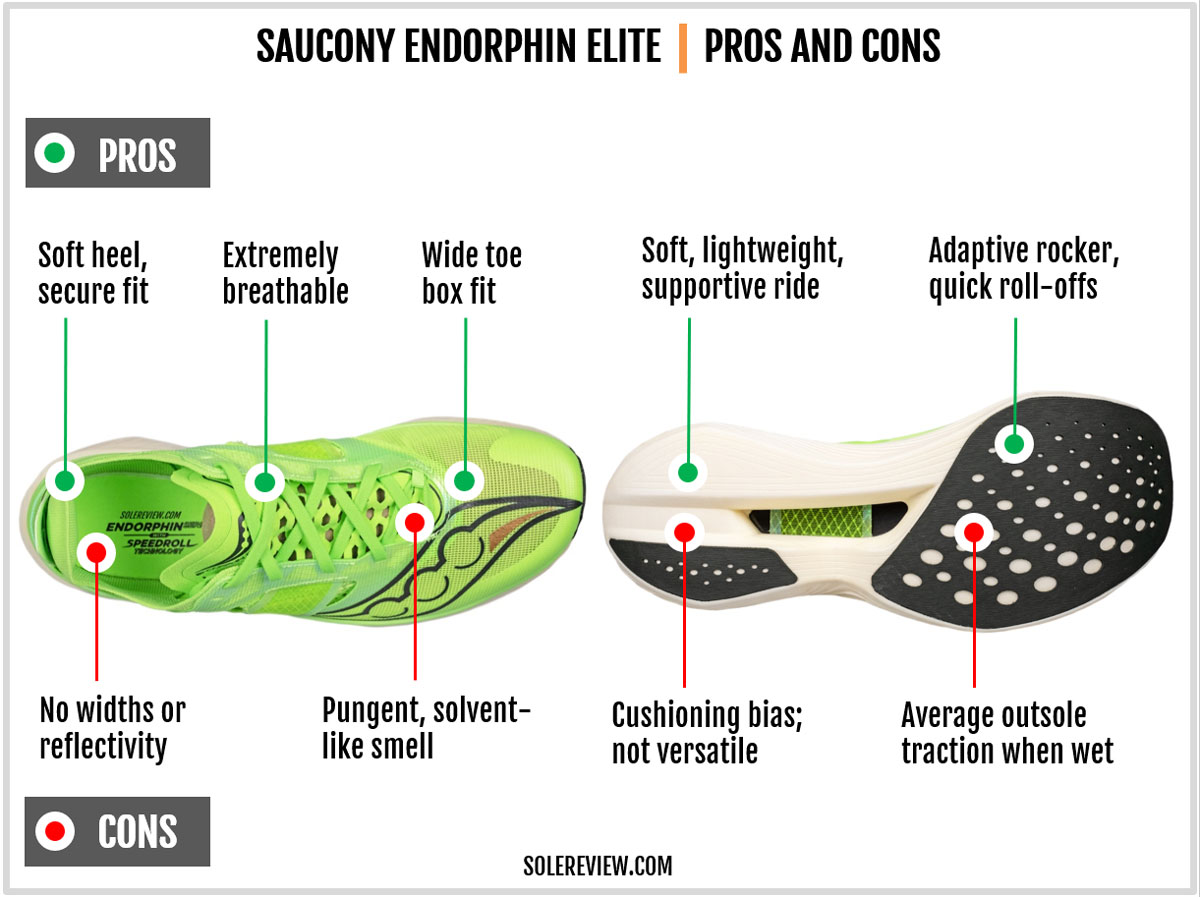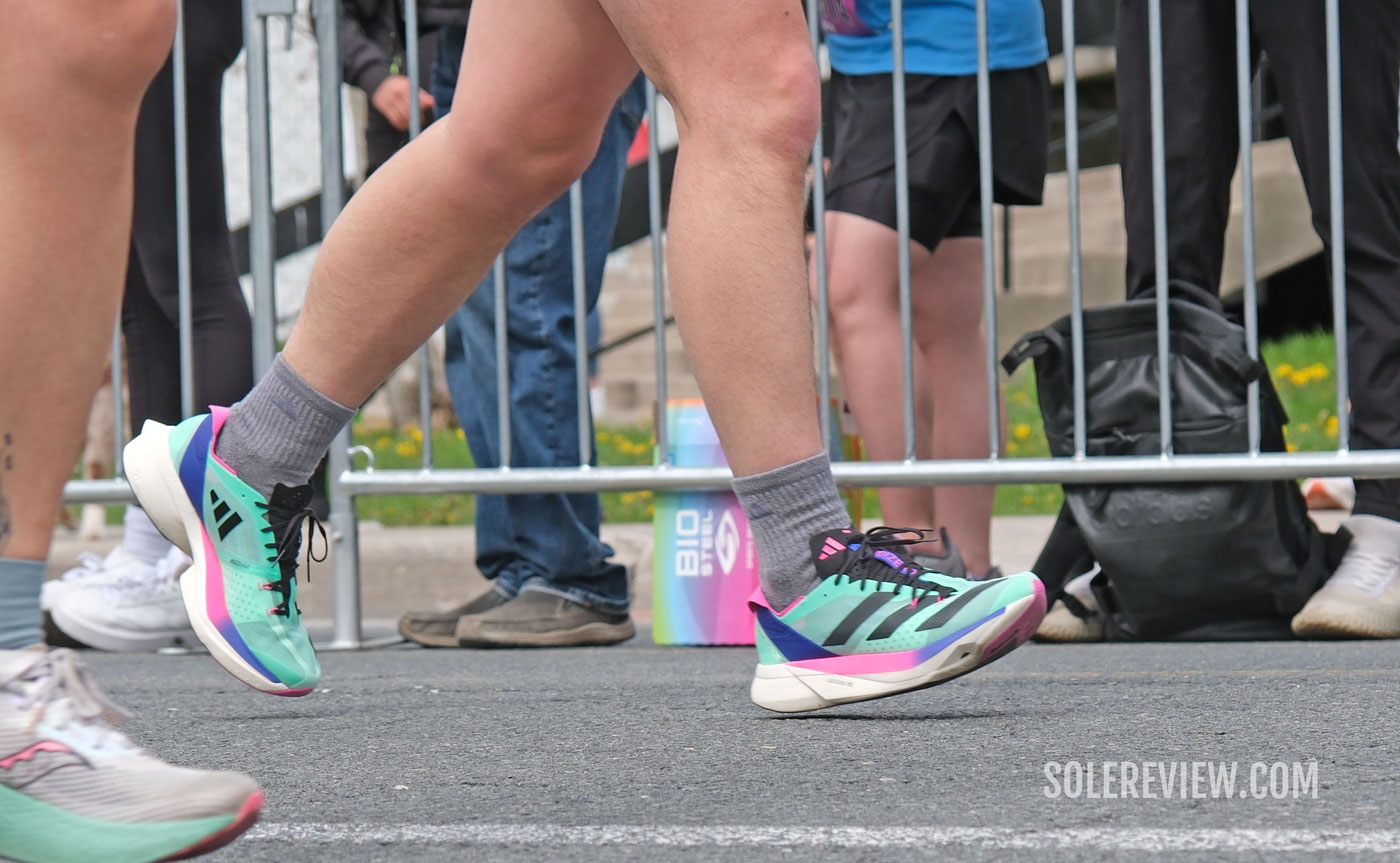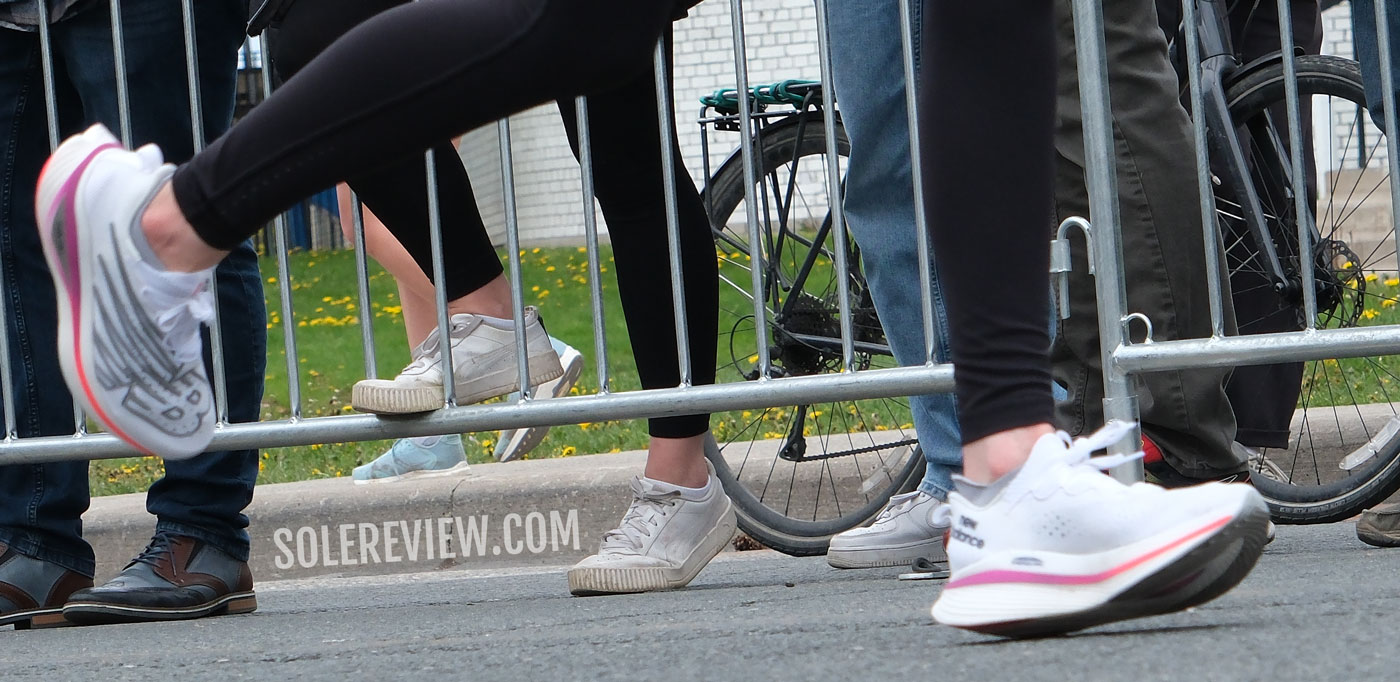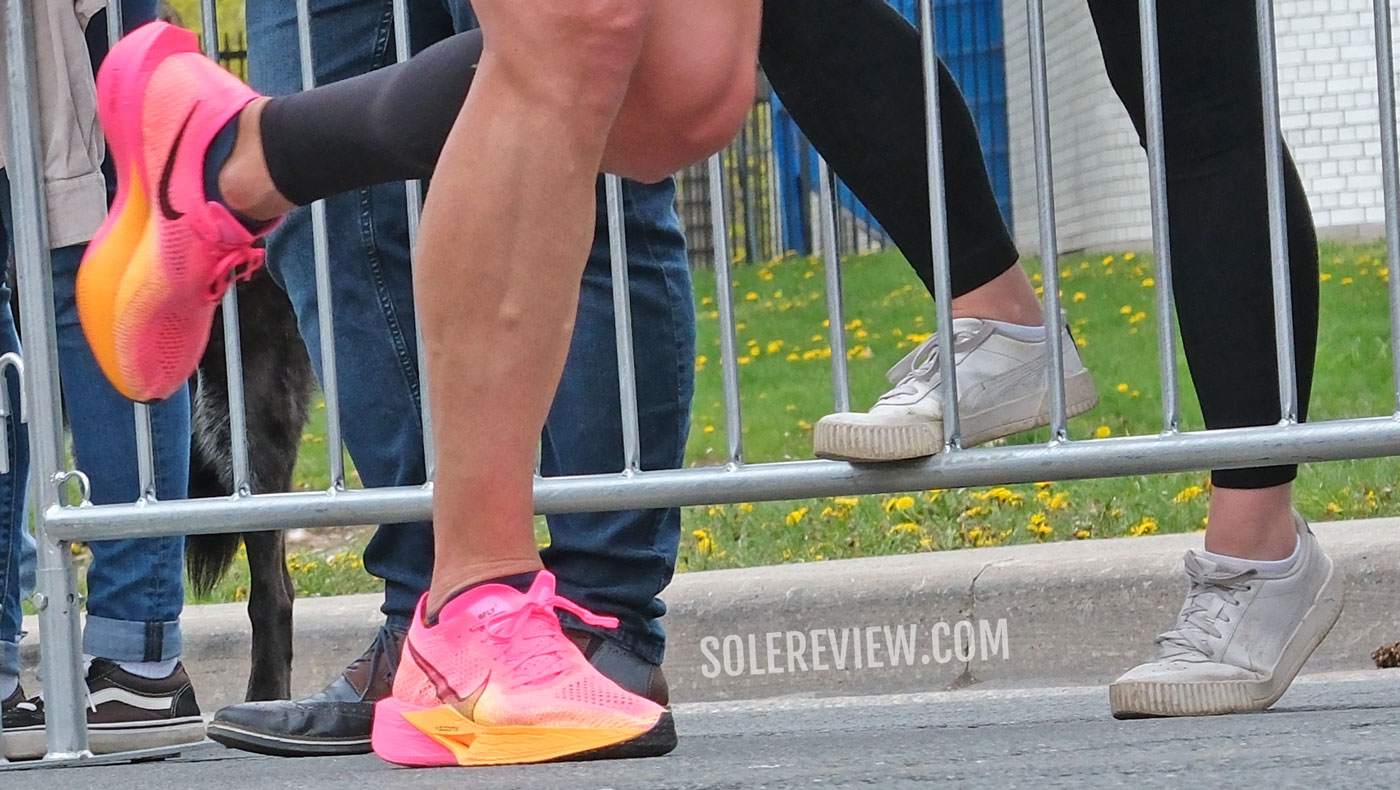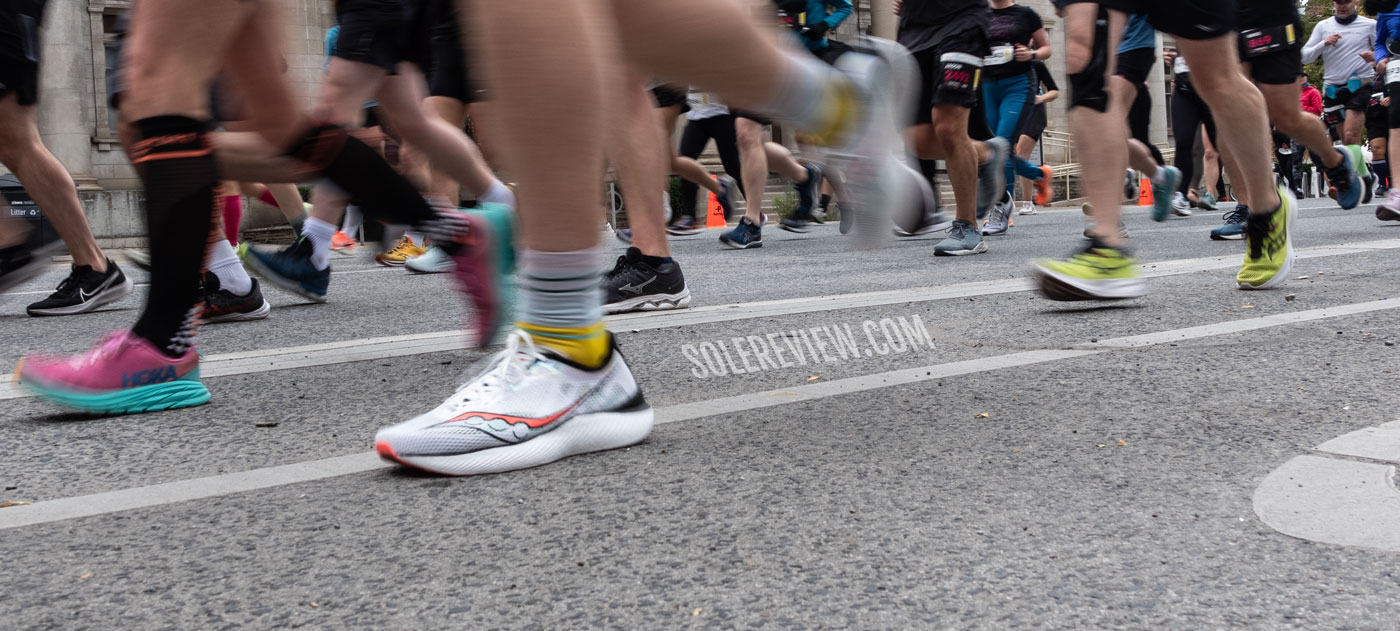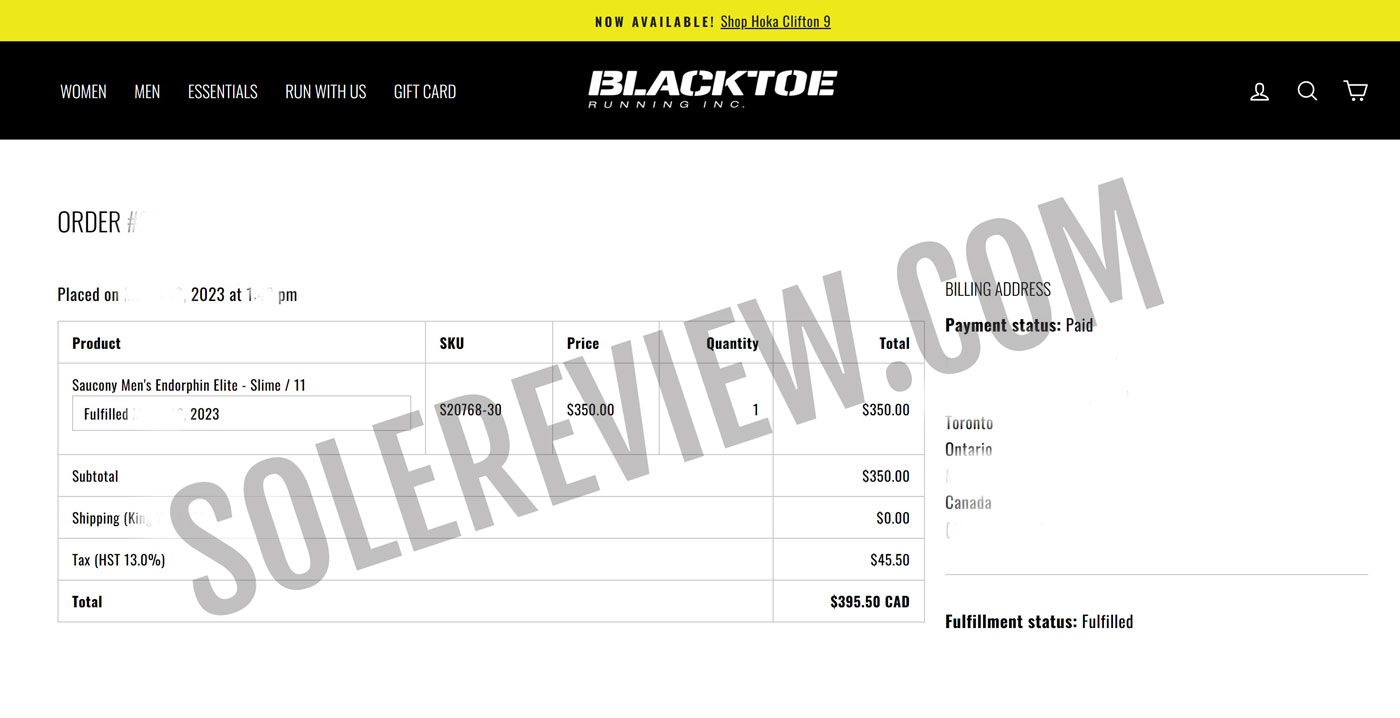
For this review, Solereview paid the full retail price for the Saucony Endorphin Elite. The amount is in Canadian Dollars.
In this review:
SUMMARY AND VERDICT
Dear reader, what do you think is the first thing that anyone notices about the Saucony Endorphin Elite? Or for that matter, the Saucony Endorphin Pro 3?
Is the upper fit? The rocker? The plate? No, it’s the pungent industrial odor from the shoe.
It’s been around since the first Endorphin, but it got worse with the Endorphin Pro 3 and Elite. To be clear, this odor isn’t to be confused with the ‘new shoe’ smell; the Endorphin’s unpleasant smell doesn’t dissipate in a day or two. The stink lingers on for weeks, and we won’t be surprised if sensitive runners develop a headache after being in close contact with the Endorphin Elite and Pro.
The likely source of this odor is the bright midsole paint. Whatever the reason, no shoe should stink the way the Endorphin Elite and Pro do.
We had to get this public service announcement out of the way, thank you.
In our review of the New Balance SC Elite V3, we wrote about the diminishing returns of new Carbon-plated racers, and why there should be a compelling reason (or two) why a runner chooses one model over another.
Buying the Endorphin Elite (over the others) makes sense if you:
1) Value a wide toe box fit.
2) Prefer a soft (collapsible) heel without a counter.
3) Value the aggressive midsole rocker that makes running less arduous in the later segments of a race.
4) Want a firmer midsole foam than the Endorphin Pro 3 and Nike Vaporfly 3.
5) Appreciate the adaptive nature of the fork-like Carbon plate.
In return, you should be okay with:
1) Higher level of visible midsole scuffing (wear) over shoes like the Endorphin Pro/Speed and adidas Adios. That being said, the overall durability is comparable to the Pro/Speed models.
2) Paying a $25-50 premium over comparable products.
3) Heel cushioning bias with a slight tilt towards the outer side.
In addition to the selection criteria, performance benefits that are normally reserved for carbon-plated super shoes are also available on the Saucony Endorphin Elite. The ultra-cushioned midsole has two things working in tandem – a firmer Pwrrun HG foam (not to be confused with Pwrrun PB) and a forked Carbon plate.
Together, these components create a cushioning environment that makes the best use of the resilient foam and flexible Carbon plate. The high-stack midsole offers long-distance ride comfort as well as a forward-propelling character – a result of the embedded Carbon plate and pronounced rocker.
The Endorphin Elite’s character is more nuanced than just ‘ lots of ride comfort with a snappy feel,’ so that’s exactly what this review is about. There are many things that we like about this shoe, and a few that we don’t.
THE MIDSOLE DESIGN AND RIDE EXPERIENCE
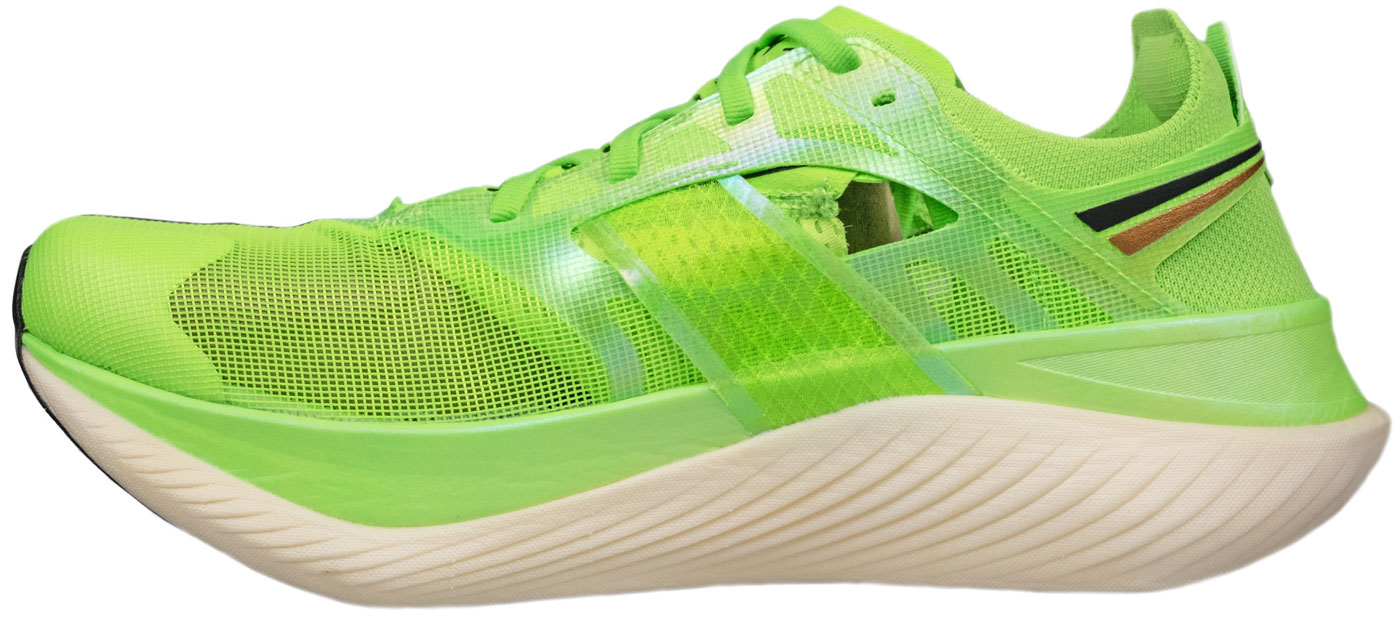
With a 39.5 mm heel stack, the Endorphin Elite is only half a mm short of the maximum permissible thickness of 40 mm.
With a heel stack height of 39.5 mm, the Saucony Endorphin Elite literally skirts under the maximum IAAF (World Athletics) regulation limit of 40 mm. The midsole has an 8 mm heel-to-toe offset, thus making the forefoot 31.5 mm thick.
It’s amazing how tall running shoe midsoles have become. Not long ago, even the most cushioned neutral trainer had heel stack heights that were lower than the Endorphin Elite’s forefoot.
Saucony hasn’t had a single original idea since the Kinvara. These days, Saucony’s product strategy involves taking an existing idea and adding value through product refinements and recognizable Saucony-isms.
Most of the time, the said process results in a good running shoe. The only outlier has been the Saucony Endorphin Shift, as it has been unsuccessful in making a dent in the Novablast’s success.
Keen-eyed runners can tell that the Saucony Endorphin Elite is clearly ‘inspired’ by the adidas adios Pro. Likewise, the Endorphin Pro used the Nike Vaporfly as its muse.
For instance, the new Pwrrun HG foam feels very similar to the Lightstrike Pro. It doesn’t stop there; the forked plate borrows its structure from the similar articulated ‘Energy rods’ of the adidas adios.
Even the rocker angle is very similar to the Adios Pro, and so is the ‘gap’ on the midsole side – except that is on the outer side.
It doesn’t come as a surprise that the Endorphin Elite rides a lot like the adidas adios Pro. The Pwrrun HG foam behaves like a slightly firmer version of Lightstrike Pro, so the cushioning has a resilient character with less give than Saucony’s Pwrrun PB foam.
We mentioned that Saucony adds value to its ‘borrowed’ creations. So what – and where – are those value-adds on the Endorphin Elite?
While Saucony’s value addition has worked very well on shoes like the Saucony Triumph (inspired by adidas Energy Boost) and Endorphin Pro (based on the Nike Vaporfly), it struggles to show through on the Endorphin Elite – especially from a ride viewpoint. Most of the value additions happen on the upper.
At first glance, it would seem that the raised heel sidewalls do a better job of seating the foot over the midsole. On the Adios Pro, the foot sits on top of the midsole. On the Endorphin Elite, the foot is cupped in by the raised edges.
However, this doesn’t mean that Endorphin Elite is ultra-stable under the heel. Despite the cupping action of the sidewalls, the midsole has a noticeable lateral (outer) bias, with greater support on the medial/arch sidewall.
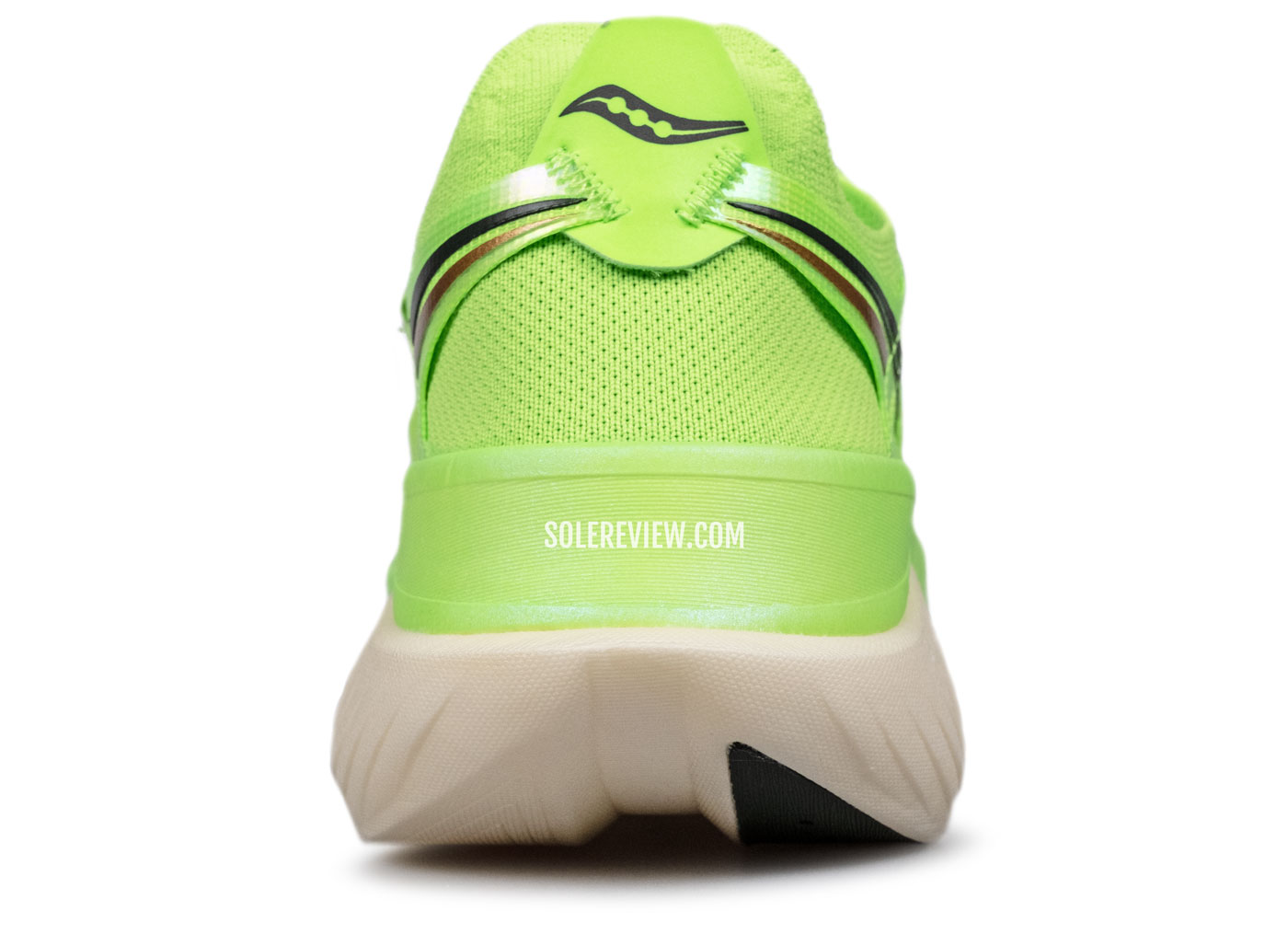
The midsole isn’t 100% neutral when supporting the heel. The inner side is more supportive, so the midsole compresses more easily on the outer side.
So the ride never feels truly neutral – there’s a noticeable cushioning bias that favors the outer midsole. We’d go as far as to say that the softer Endorphin Pro is more neutral than the Elite.
The Endorphin Elite ‘borrows’ two other features that define the adidas adios Pro. The very aggressive forefoot rocker makes it easy for the foot to tip forward; this proves useful during the later stages of a long run when you want the shoe to share the transition workload.
Runners who have run in the adidas adios or the Asics Metaracer will recognize the familiar ride signature of an articulated Carbon plate. Well, the adidas adios doesn’t have a plate per se, but its forked ‘Energy rods’ work the same way the plate on the Endorphin Elite does.
Here, the Carbon plate is articulated like a fork under the forefoot. This gives the plate a range of motion (past the rocker) that is otherwise absent on a stiff and solid plate. The flexibility gives the foot greater autonomy during roll-offs, as it’s easier to direct the power where it’s needed.
The forked plate has the unmistakable ‘snap’, but with a deeper level of engagement than a conventional plate.
The Endorphin Elite is more than the sum of its parts. The deep cushioning is consistent and supportive, and the plated architecture and forefoot rocker promote high-speed runs.
This is Saucony’s premier race-day shoe, so 3 min/km or 5 min/mile paces (ideally, midfoot strikes) are what it was built for. Its 7.2-ounce (204-gram) weight minimizes distractions during a race. The sockliner is glued tight to the lasting, so there’s no fear of it sliding up the heel during a race.
Slower runs are doable as well. The Pwrrun HG midsole supports rearfoot strikes, as the firmness of the foam also prevents the foot from sinking into the foam at slower paces. The heel is generously beveled, so the midsole edge doesn’t catch the ground.
On the flip side, rearfoot strikes at easier speeds (5:30 min/km, 8:50 min/mile or slower) accentuates the lateral bias. This makes the shoe feel less neutral than it does at higher speeds. Under these conditions, the heel feels off-balance and skewed towards the outer side.
The outsole traction is where the Endorphin Elite loses points to the adidas adios Pro. While Saucony uses a sheet-like outsole with perforations, that’s where the similarities end.
The outsole has nothing on adidas’s Continental rubber outsole, and the performance gap becomes quickly evident on damp roads. When in contact with a wet surface, the Endorphin Elite doesn’t inspire confidence as well as the Adios Pro does.
RECOMMENDED ROTATION
The Saucony Triumph 21 or Asics Superblast pair nicely with the Endorphin Elite.
Both are versatile neutral trainers that are durable, cushioned, and supportive. While both shoes fill this rotational need well, our vote goes to the Asics Superblast. It’s such a great do-everything shoe that the Triumph 21 pales in comparison.
Unlike New Balance and Brooks, Saucony doesn’t have a low-profile pacer like the Rebel 3 or Hyperion. Sure, the Kinvara 14 can stand in for that role, but it’s not the same thing. Besides, the Kinvara 14’s taller midsole makes it softer than the 12 and 13.
Our ideal three-shoe rotation would be the Asics Superblast and New Balance Rebel 3 grouped with the Endorphin Elite.
IS THE SAUCONY ENDORPHIN ELITE DURABLE?
This is an interesting topic. The Endorphin Elite has scant rearfoot outsole coverage; only the outer heel has rubber.
Also, the rubber doesn’t provide 100% protection on the edge of the midsole as the adidas adios Pro does. The Adios Pro’s outsole rubber also curves over the edge – something that the Endorphin Elite doesn’t do either.
Surprisingly, the exposed Pwrrun HG foam that’s directly under the heel has excellent abrasion resistance. At the 75 km mark, very little wear and tear was noticed.
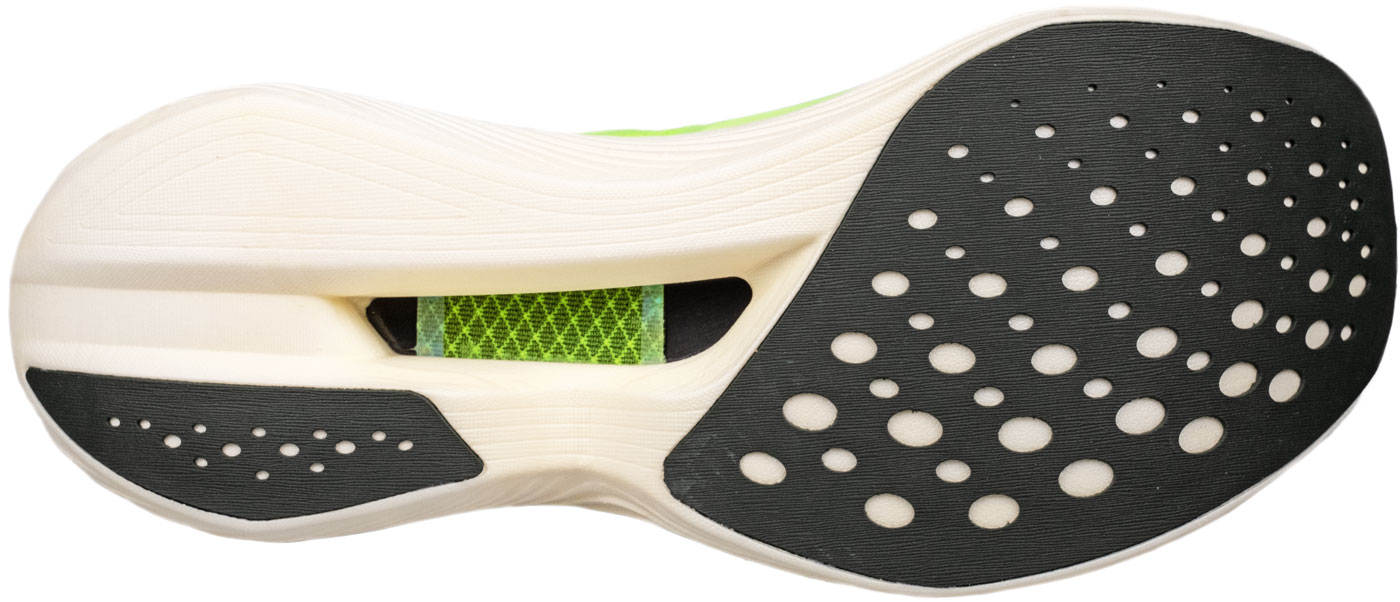
The exposed foam on the lateral side does just fine. However, rearfoot strikers will see noticeable scuffing at the foam edge under the heel rubber lug.
However, the edge that comes in contact with the ground gets scuffed very quickly. The rate of wear slows down past 50 km, but the shredded edges stay on over the life of the shoe. While the superficial damage is quite visible, it doesn’t affect the performance.
Our experience tells us that a lifespan of 400 miles is a reasonable estimate.
THE UPPER DESIGN AND FIT
If you have a thing for a plate-equipped super-shoe with a wide toe-box, you’re in luck. The Saucony Endorphin Elite has the roomiest toe-box in its class; the broad toe box profile and molded stiffener create plenty of wriggle room. The ceiling height is just right too.
That doesn’t mean that the forefoot fit is ultra-relaxed. It locks the foot in to prevent slippage; the lacing begins closer to the tip of the shoe for better fit security.
The lacing has progressive width, meaning that it starts narrow at the base and widens towards the rear. This makes the lacing more effective. The soft and elastic laces do not create a hot spot over the ventilated tongue.
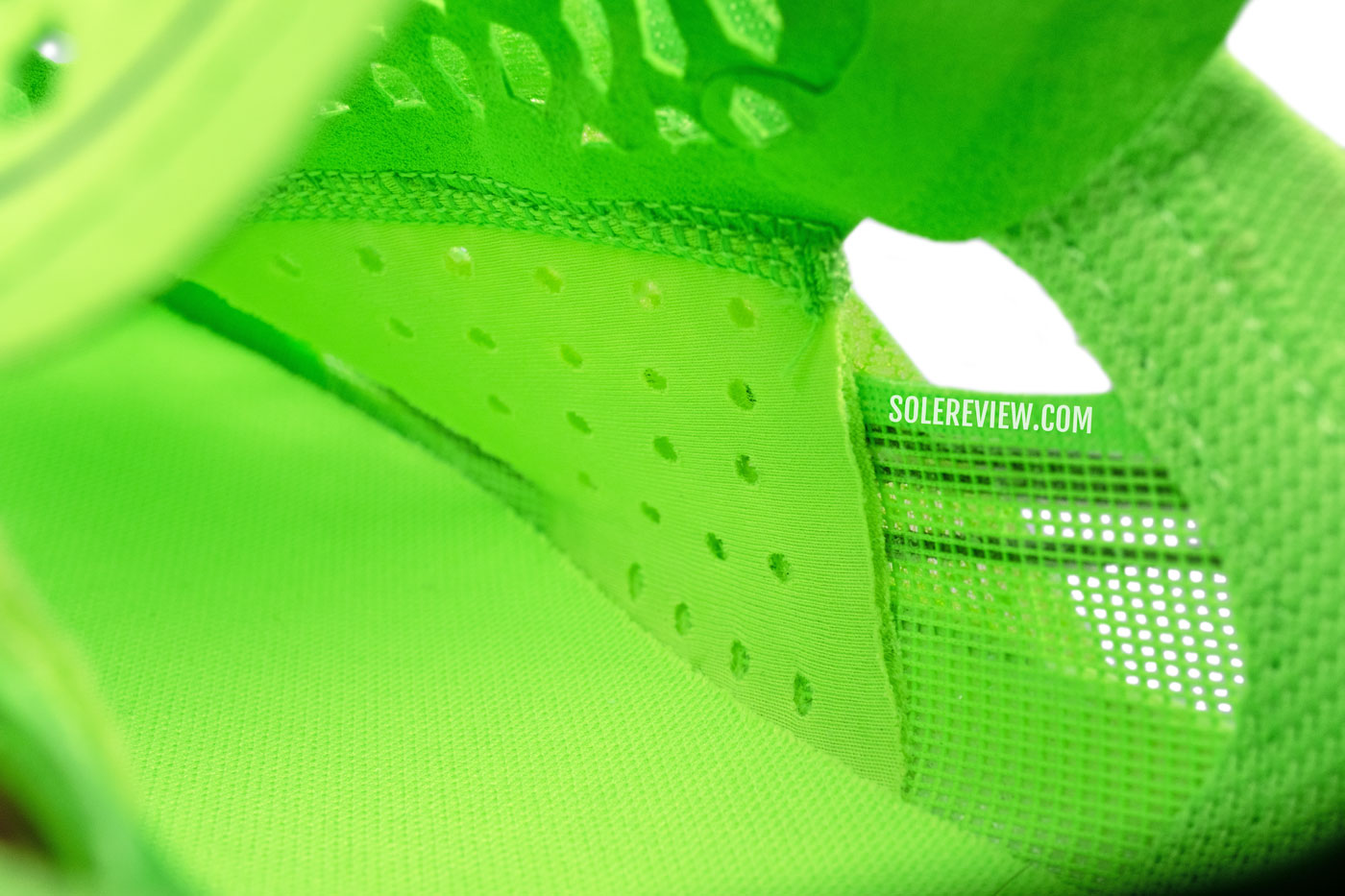
Note that the gusset on the lateral/outer side has perforations – the one on the arch side does not.
Very little gets in the way of upper ventilation here. The tongue has a gazillion hexagons punched into it, and large openings on the midfoot panel cool the foot during long runs. The single-layer mesh has a wide weave for ample breathability. The tongue is tied down by a couple of internal straps that do not hinder ventilation.
There are a couple of straps that flank the midfoot, and at first, it might seem that they make the fit adjustable. They don’t – the straps are in a fixed position, so they are not adjustable. Historically, Saucony has used straps (‘Prolock’, remember?) to achieve some level of fit customization.
However, that’s not the case here. The band also wraps around the Carbon plate, but it exists to achieve an aesthetic effect rather than a functional one, as the band is glued tight to the plate.
The only perceivable benefit of the strap is that it anchors the midfoot over a wider base. Theoretically, this should result in a minor upside to the quality of midfoot lockdown.
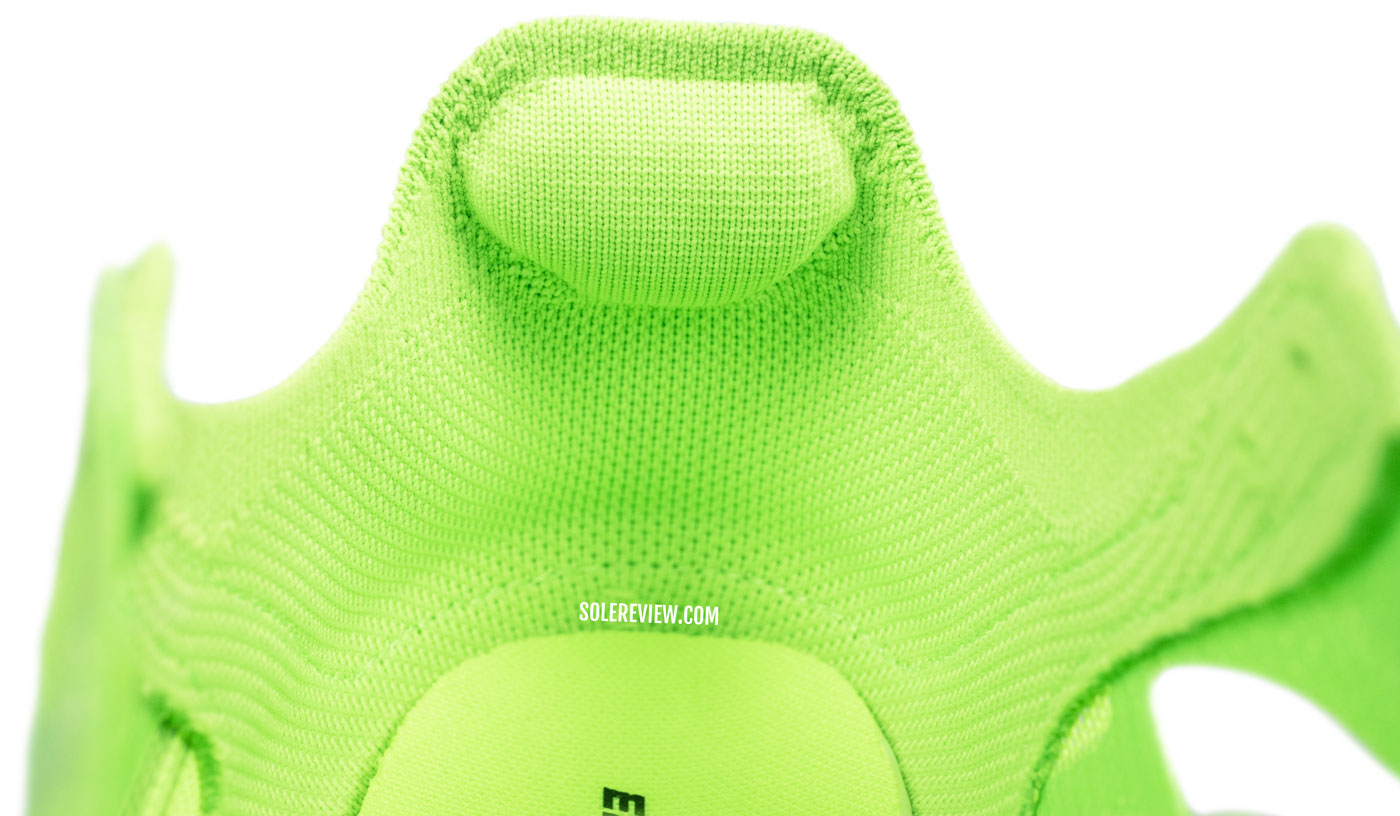
The Endorphin Elite has the softest heel fit of all plated racers. This is good news for runners who have sensitive Achilles.
The soft heel fit is interesting, yet effective. It’s one of those value-added features that differentiate the Endorphin Elite from the rest. Only a tiny foam ‘pillow’ pads the Achilles; the rest of the heel collar has no foam.
With no stiffener, the collapsible heel can be folded flat. This is easily the best shoe for runners with sensitive Achilles.
So if there is no internal counter, how does the heel prevent slippage? An extension of the midfoot wraps around the heel, and it’s very good at what it does.
As with most shoes of its kind, reflective elements are not available in any form.
ORTHOTIC COMPATIBILITY
The ‘non-removable’ footbed can be unglued with mild effort, so it’s possible to sneak in an orthotic if your mind is set on it.
That said, the thin Pwrrun PB insole is die-cut and non-molded, so that limits your options.
PROS AND CONS
We prefaced this review with the reasons why one should get the Endorphin Elite over other comparable racers. As it turns out, the same reasons are its strengths. The fork-like design makes it easier for the foot to control the plate, and the aggressive rocker makes the roll-offs quick and efficient.
The wide toe-box and soft heel make the upper comfortable and accommodating. The ventilation is excellent, and so is the overall fit security.
The heel isn’t as neutral as it looks; there is a cushioning bias that favors the outer/lateral side.
That means that the Endorphin Elite isn’t the best shoe for slow-paced rearfoot landing. Those conditions make the instability more pronounced than one would experience under high-speed midfoot striking.
Hence, the Endorphin Elite’s versatility is constrained by its laterally-biased midsole, and that docks a point off the overall score.
Also, we really wish Saucony would do something about the horrid solvent-like stink – both on the Endorphin Elite and Endorphin Pro.
SHOES COMPARABLE TO THE SAUCONY ENDORPHIN ELITE
Considering that the Saucony Endorphin Elite is modeled on the adidas Adios Pro, the latter is the closest match in ride quality.
Though the adidas Lightstrike Pro is marginally softer, the articulated Energy Rods and rocker angle behave similarly. The Adios Pro has an identical heel stack (39.5 mm) and a marginally taller forefoot.
The Endorphin costs $25 more than the adidas adios Pro, so that’s for you to decide if the shoe is worth the premium. The Endorphin Elite’s upper is the better of the two; its forefoot fit is more refined and better proportioned than the adios Pro.
Other than the fit, smaller touches like the softer mesh, stretchy laces, and more comfortable heel lock-in make the Endorphin Elite’s upper superior.
If you want a tighter yet comfortable upper, the New Balance SC Elite V3 is the shoe for you. Its neutral midsole is more forgiving for slower speeds and rearfoot strikes. It also has excellent straight-line tracking due to its unique transition channel.
Towards the ‘traditional’ spectrum of Carbon plated racers are models like the Nike Vaporfly 3 and Saucony Endorphin Pro. And don’t overlook the Saucony Endorphin Speed 3 – it has most of the performance benefits of a super shoe, but without the stratospheric price tag.
Do you own this shoe? Improve this review by sharing your insights.

